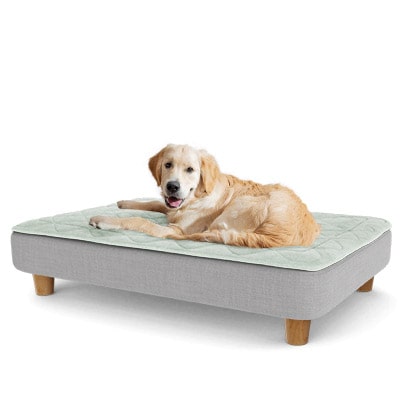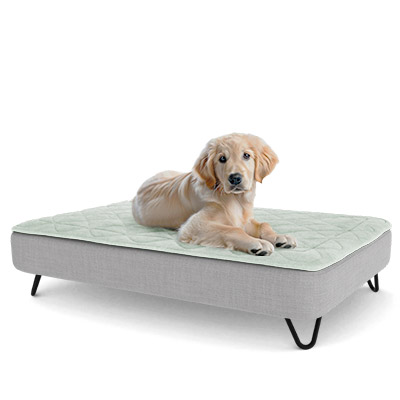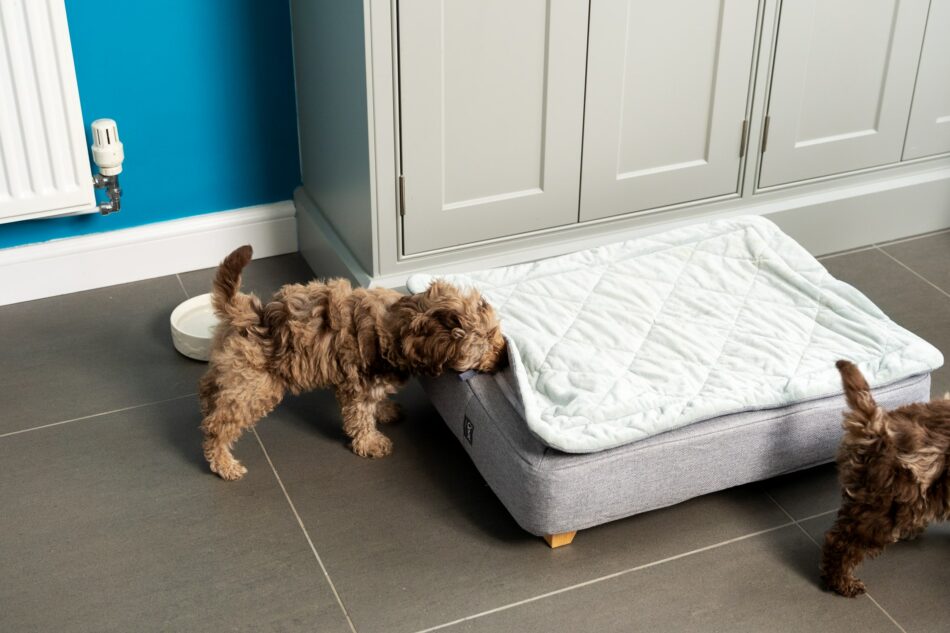
Ahh, the eternal question: how long should a dog bed last? It’s a topic that’s stumped pet owners for ages. As humans, we typically change out our mattresses every 6-8 years depending on brand and usage. But with dog beds, there are a lot more factors to consider. Should a dog bed last a year? Five years? Ten years? Or should it last until the end of time itself? At Omlet, we think dog beds should last forever! So let’s take a closer look at your dog’s bed and what you can do to keep their comfort going for life and keep their bed out of the landfill.
Why standard dog beds don’t last
Let’s be honest – dogs are known for many things, but being gentle with their belongings is usually not one of them. They love to chew, dig, and drool on anything they can get their paws on, including their dog beds. In addition, most dogs sleep on their beds for all naps and nighttime sleep, incurring lots of usage and extra smells. It’s fair to say that dogs use their beds more than humans use their mattresses.
As a result, standard dog beds simply can’t withstand the normal wear and tear of any dog breed. Most standard dog beds are constructed of non-durable and non-washable materials, making them unable to provide quality comfort for your dog for very long. So if you’re expecting a standard dog bed to last forever, you’re barking up the wrong tree. But rest assured – there are other dog bed options from Omlet available that will keep your canine comfortable for life.
How long should a dog bed last?
On average, most standard dog beds last anywhere from 6-12 months. If it’s not the rips and tears from your dog’s natural behaviours that prematurely send it to the landfill, then the build-up of odours and hair will. At Omlet, we believe that dog owners should be able to buy one dog bed that will last their furry friend from puppyhood to prime.
Our product designers set out to challenge the standard dog bed norm and create a dog bed that would not only provide the highest quality comfort to your dog, but would last their lifetime as well. Their solution – the Topology dog bed.
3 ways to know it’s time for a new dog bed
How do you know when it’s time to buy yourself a new mattress? More than likely, it’s when you start having consecutive nights of uncomfortable sleep or can see defined lumps and dips throughout. But how do you know when it’s time for your dog to have a new bed? Here are 3 ways you can determine if your dog needs new digs:
The two most common dog bed fillers are stuffing and memory foam. So in order for any standard dog bed to stay supportive of your dog’s joints and comfort, the interior filling needs to be uniformly thick across. But how can you tell? By performing a quick thud test. Simply take your flat hand and hover it a few feet above your dog’s bed. With a swift motion, drop your hand onto the dog bed to mimic your dog plopping onto their bed. If you hear a ‘thud’ when it hits, then it means the supportive filling has gone flat and it’s time for a new dog bed.
No really, we mean it – smell your dog’s bed. And we don’t mean from the other room. We mean get down on the ground and give your dog’s bed a good whiff. Any bacteria or other microbes that may have started to build up inside your dog’s bed may only be fragrant up close. But guess what? That means this smell is transferring to your dog every time they snuggle up for a snooze. So if you sniff a bad whiff it’s time for a new dog bed.
Give a complete inspection
At first glance, most standard dog beds may appear to be in perfectly good shape. But give it a closer look and you may see something else. In order to really know if your dog needs a new bed, you need to give it a thorough inspection. If the cover is removable, take it off to look at the insert. Mould and mildew can hide in seams and crevices from excess drool, making your dog’s bed worse for wear. And if the inside of your dog’s bed looks that bad, imagine how uncomfortable it must be.
Omlet’s Topology dog bed
As the pet company that does things differently, we set out on a quest to create a comfort solution that would be your dog’s sleeping companion for life. We’re pet owners, too, and like you, we’re tired of worn-out, uncomfortable dog beds filling up our landfills. So we decided to do something about it. We decided to engineer the last dog bed you’ll ever need to buy.
The Topology dog bed, designed by Omlet, is a completely customisable dog bed that will literally transform your dog’s sleep. The luxurious memory foam mattress is completely encased in a water-resistant cover to give your dog high-performance sleep without the worry of bacteria build-up. And with Topology, you can also customise your dog’s comfort with one of the multiple different topper options so you can give your dog the exact sleep they want.
The best part? Every single topper is easy to remove and completely machine washable. Simply pop a new topper on the bed while the other is in the wash, or if a topper gets worn out, simply replace it with a new one without having to buy a new bed.
Omlet and your dog
At Omlet, we don’t just assume we know what your dog needs in a dog bed. We use our personal experience and unparalleled understanding of the best products available to engineer dog beds that deliver quality, comfort and ease of care so your dog not only gets what they need, but also what they want. After all, our dogs deserve the best, right? With the Topology dog bed, your dog will be laying in the lap of luxury from puppyhood to prime and giving you many tail wags of thanks in return. Let us do the work, so you can reap the rewards.
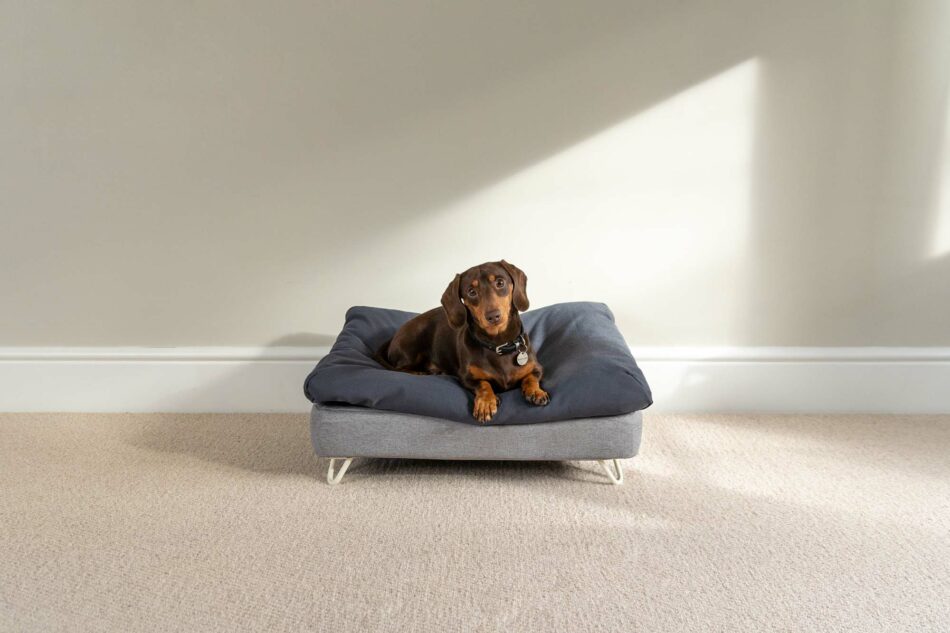
This entry was posted in Dogs
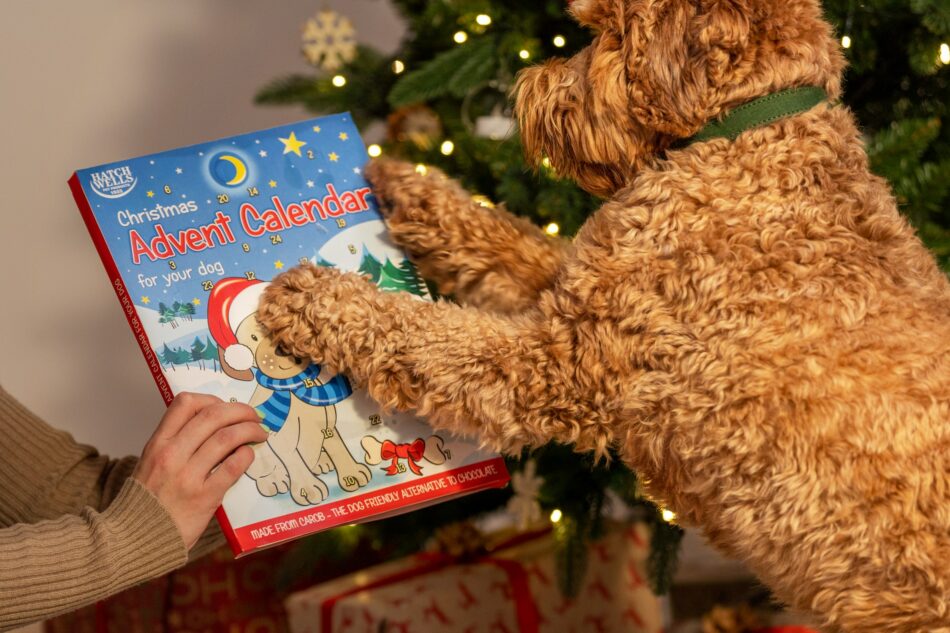
Christmas is the time for all the family to enjoy – our pet pooches included. We know that dogs are best off sticking to their normal food over the holidays but ignoring those puppy eyes beaming up to the dinner table is notoriously difficult. If you know you won’t be able to resist sneaking your furry friend some festive treats, it’s important to know what Christmas foods you can, and what Christmas foods you definitely can’t, give your dog.
Christmas foods that your dog shouldn’t eat
Starting with the basics, your dog should never be encouraged to join in with Christmas drinking. Even a small amount of alcohol can be dangerous. There are also several traditional festive food goodies that you should not share with your pet:
- The bones and skin from the turkey or chicken
Bones from any bird can be dangerous. They can get lodged in the throat, becoming a serious choking hazard, and can break into small sharp pieces that can pierce the lining of the stomach or intestines. Turkey skin is extremely fatty, which is not only unhealthy for dogs, but can cause serious problems with their pancreas. - Gravy
You may think that gravy is delicious and completely harmless, but it’s high in salt and fat, both of which can be dangerous to dogs. - Onions and other bulb vegetables
All types of alliums are poisonous to dogs, so it’s important to keep your pet away from them. Onions are the main cause for concern, but other bulb vegetables, like garlic, can also cause serious problems. - Grapes, raisins, currants and sultanas
All of these items are highly toxic to dogs. In fact, if your pet eats even a small amount, you should seek help from a vet as soon as possible. For this reason, Christmas treats such as Christmas pudding, Christmas cake and mince pies should never be fed to dogs, and ideally be kept out of reach at all times. - Chocolate in any form
Chocolate is a favourite in most homes over the holidays, but it’s very bad for dogs. It contains theobromine, which can be deadly to your furry friend even in small amounts, so don’t let them have any, no matter how much they give you the sad eyes treatment.
You should of course not serve any of these foods to your dog at any time of the year, but it might be a good idea to keep an extra eye on your dog during the holidays, as leftovers might be left on the table while you enjoy a game of charades, or well-meaning guests might try to sneak your pooch a bit of Christmas cake. It’s a good idea to tell everyone not to feed the dogs anything, and then, if you really want to, you can treat them to some canine-friendly festive food yourself. Here are a few things that are fine for dogs to eat.
Christmas foods that your dog can eat
Christmas won’t be ruined for your dog if they don’t get a special Christmas dinner, but if you want them to join in with the celebrations, you can try some of these things. It’s important to remember that all of these foods should be given to dogs in moderation – keep portions small.
- A few slices of turkey
You can give your pet some white turkey meat, as long as the skin and all bones have been removed. - Boiled and mashed potatoes
Dogs will enjoy a small amount of boiled or mashed potato. Remember that you should only ever feed your pet plain potato with no salt or butter added. - Other vegetables
As with any other food items, do not give your dog a pile of vegetables, but it’s fine to let them have a try of a few selected items from the Christmas meal. Sprouts, swedes, parsnips and green beans are normally very popular with dogs, as is a raw or cooked piece of carrot. Do not add any seasoning, butter or sauces before you give the vegetables to your pet, however. - Eggs
Many of us enjoy some scrambled eggs on Christmas morning, and this is another thing you can give to your dog as a treat. In fact, eggs contain lots of beneficial vitamins and minerals, and can make the dog’s coat shinier. Again, you should not add any butter or salt to the eggs, and it’s best to keep portions small. - Fruit with pips or stones removed
Most fruits in the fruit bowl can be shared with your dog, as long as pips or stones are removed, and items like bananas and satsumas are peeled. You should however remember that fruit is acidic and contains a lot of sugar, so can cause stomach problems in dogs if they have too much.
Omlet and your dog’s Christmas
Whichever foods you’ll be tucking into over the holidays, Omlet has just what your pup needs to have to make sure it’s their best yet. Our easy-to-clean dog beds are perfect for messy pups this season, and our ingeniously designed dog crates are ideal for when Fido needs a break. So, now you know what foods are on and off the menu, it’s time to enjoy the festivities, knowing your canine companion will be staying safe.
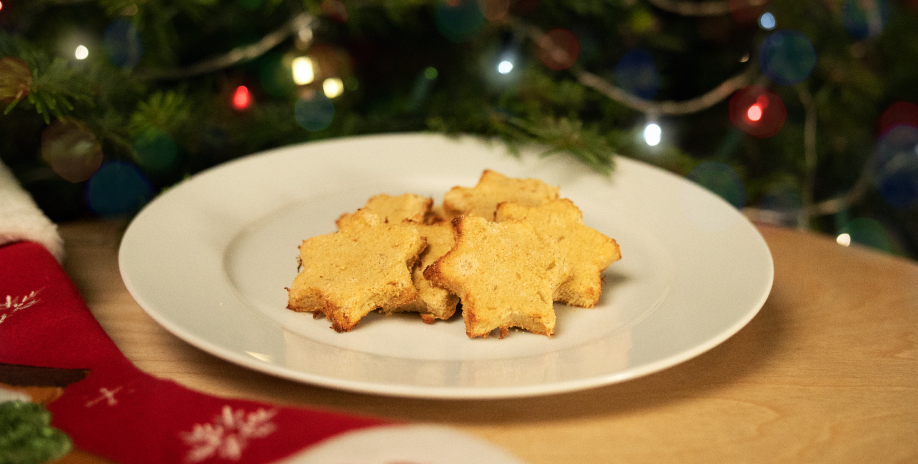
This entry was posted in Dogs
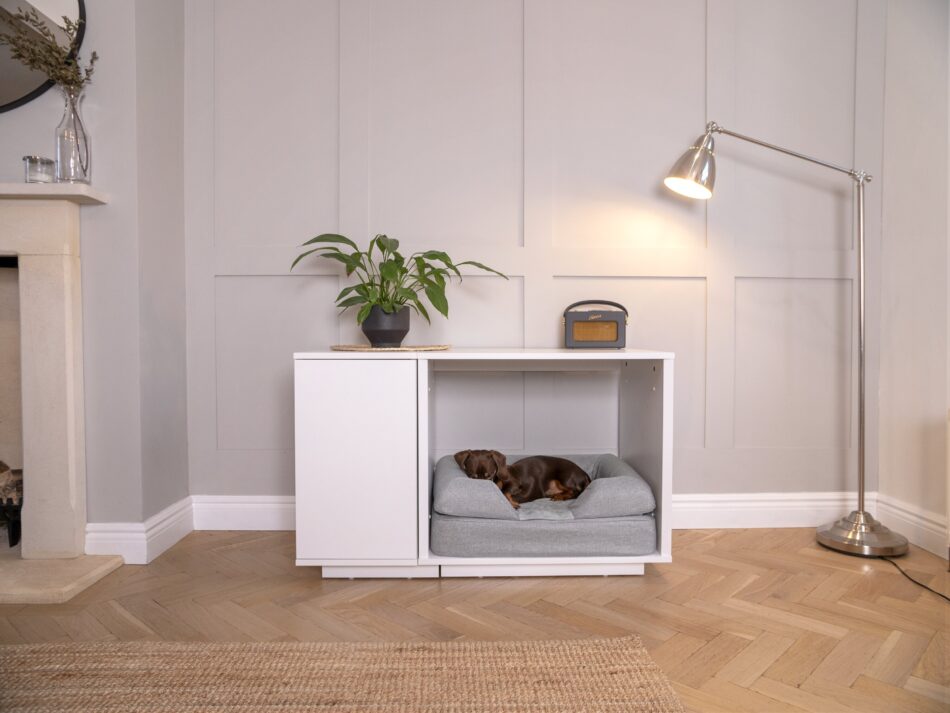
Finding the best dog crate is a crucial decision for pet owners, regardless of whether you have a small, big, high-stress, or elderly dog. It’s an essential tool for their safety, comfort, and overall well-being. With the vast array of options available, the quest for the ideal dog crate can be overwhelming. Thankfully, we’re here to help you navigate this very important decision with various options of Omlet dog crates that are suitable for all pups in all situations.
How to choose the best dog crate for your furry friend
Choosing the best dog crate for your beloved furry friend is like selecting the perfect home – it should be cosy, safe, and tailored to their unique personality. There are three main things to consider when choosing the perfect crate for dog:
First, consider the size; your dog crate should be spacious enough for your dog to stand, turn around, and stretch comfortably, regardless of their size. And remember to also account for your dog’s growth if they’re still just a puppy – as your dog grows, so, too, should their crate.
Next, think about storage. Where are you going to put your dog’s crate? Will it stay in your bedroom? Or will it be front and centre in your living room? Whether you’re using the dog crate just for training purposes, or for a safety spot for them to relax, you will need one that is strong and durable. If you plan on using it as a doggie den for your furry friend, you may want to consider a dog crate that is built more like furniture and can complement your decor.
Lastly, you need to think about how you are using the dog crate. For many pet owners, a dog crate is only used for safety reasons, i.e. travelling in the car to the vet or on holiday. In this case, a dog crate that is easy to collapse and fold is ideal and will make both you and your dog’s lives easier! In addition, an easy-to-transport dog crate also means no hassle, and you’ll be able to move it around your home should you decide to change its location.
Best dog crates for large dogs
Big dogs need big things. And that includes dog crates. So if your furry friend is large like a German shepherd, Labrador, or Bulldog, you’re going to need a dog crate that will fit their size and stature. Our top choice is the Omlet large dog crates as they are designed with larger breed dogs in mind, providing ample space for them to stretch out comfortably and move around in. Its double doors not only allow for easy access, but flexibility of placement as well.
Best dog crates for small dogs
When it comes to small dog crates, Omlet has a range of design options engineered to cater to both the comfort of your smaller dog’s needs and the design of your home. The Fido Studio is a standout choice for petite breeds like the chihuahua, dachshund, or papillion as it offers a cosy den-like enclosure that also doubles as a piece of furniture. With its modern design, your pint-size pup will feel secure and safe in a comfortable spot that blends seamlessly into your home. Store your small dog’s favourite accessories in the optional wardrobe and create a room all their own.
Best dog crates for puppies
When it comes to puppies, dog crates are an essential part of parenting. Not only are dog crates crucial for their safety and puppy training, but for their comfort as well. The Omlet Fido Classic crate is an excellent choice for several reasons. Firstly, it provides a secure space where your puppy can’t get into mischief or danger. Which, in turn, also helps reduce the risk of destructive behaviour!
Second, a dog crate for your puppy aids in-house training by leveraging a dog’s natural instinct to not use their sleeping area as a potty. Consider it a “bladder controller” that helps prevent indoor accidents.
To use a dog crate effectively for your puppy, ensure it’s appropriately sized, allowing them to move around in it freely and comfortably. Introduce positive associations, such as dog treats and dog toys, to make the crate a welcoming space. Then, gradually increase crate time so they become familiar with and used to using it as a spot for security. After a while, you can add a comfy puppy bed inside the crate to make this their designated spot.
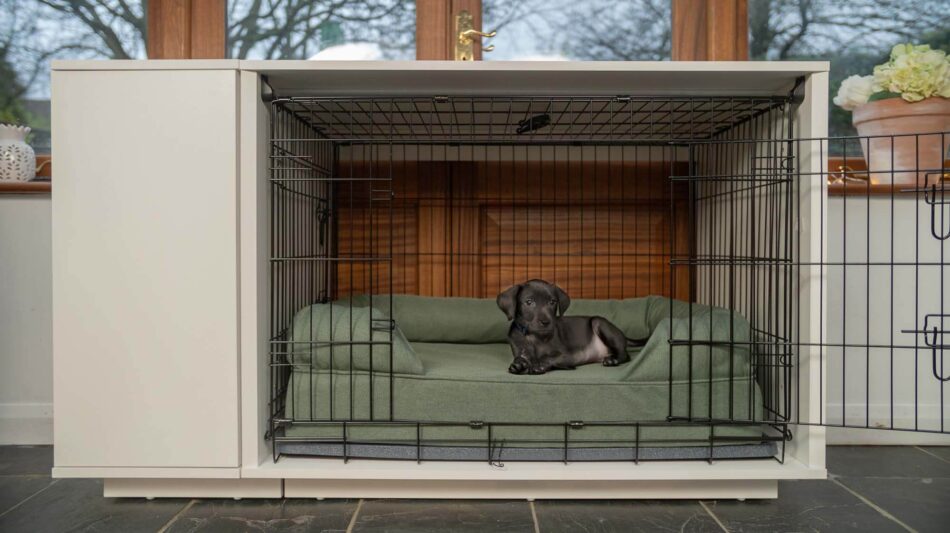
Best dog crate for senior dogs
You may be asking, “why would my senior dog who has lived their whole life without a dog crate suddenly need one?” Great question – we’re glad you asked. As dogs age, their needs change, and a dog crate can become a valuable addition to their life. Some senior dogs start to experience mobility issues or incontinence in their later years, and a dog crate becomes a safe and manageable place where they can rest and recover.
But can you teach an old dog new tricks? At Omlet, we know you can. Training a senior dog to use a dog crate is no different than training a puppy – it takes consistency, patience, and time. When it comes to reducing the stress and anxiety often associated with senior dogs, look no further than the Omlet Fido Nook. Curated with luxury and comfort in mind, this modern dog crate has been meticulously designed to give your dog a sense of comfort and priority in your home.
Best dog crates for travel
Embarking on a pet-friendly holiday should be easy. That was our thought process when we designed the Omlet dog crates to be versatile for travel with your favourite furry friend. Whether you’re road-tripping with your dog in the car or jet-setting across the country, our thoughtful design features help to give you and your dog a hassle-free travel experience. The tool-free assembly of the dog crate makes setup a cinch and your dog will love the cosy interior that keeps them safe during transit. Holidaying with your four-legged family member has never been so convenient.
Best dog crates to calm anxious dogs
Finding the perfect dog crate to soothe your furry friend’s anxiety is like discovering a cosy hideaway for their heart. The Omlet dog crates are not just enclosures, they’re ergonomically designed havens of hushed tranquillity that transform anxiety into calm. Many dogs will whine or bark as a show of their unease but using a dog crate as a calming tool will help give them a safe place where they can feel less overwhelmed.
Best dog crate furniture
At Omlet, we believe dog crates should provide a space of comfort and peace for your dog while simultaneously not distracting from your decor. We asked ourselves, why can’t a dog crate be both functional and modern? And then we made it. Meet the Fido Nook Dog House – where dog crates are elevated to luxury that your dog deserves. Crafted with precision and style, we transformed the mundane dog crate into a statement piece, making your home a sanctuary of style and warmth for both you and your dog.
With the option to add a removable classic crate or just place your dog’s bed directly inside, the Fido Nook is truly the only dog house you’ll ever buy. The integrated closet acts as a storage unit for all of your dog’s accessories and helps to keep your house clean and tidy. This dog house serves as more than just a retreat, it’s a conversation piece in your home that is a testament to your love for your furry friend.
Create the ultimate den for your favourite canine
Now that you’ve settled on the perfect dog crate, it’s time to make it comfortable for them to settle into. Start by adding a cosy dog bed where they can rest and relax. Using a dog bed in your dog’s crate will help train them to know that this is a safe place to be and feel calm. Next, top off their cosiness with comforting dog blankets that keep them warm and snuggled. It won’t take long for your favourite canine to learn that their dog crate is the ultimate den where they can feel secure, comfortable, and at peace.
Omlet and your dog
At Omlet, we go beyond the ordinary to invent the extraordinary, creating remarkable designs that last a lifetime. Whether it’s our dog crates, washable dog beds, or raised dog beds, we have the products your dog needs and deserves. Our mission is simple: make pet products better so you can spend less time worrying about them and more time with the furry friend you love.
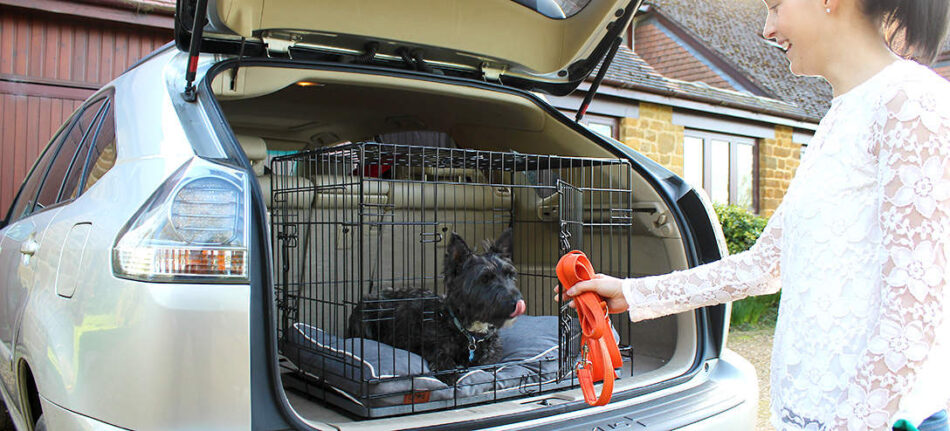
This entry was posted in Dogs
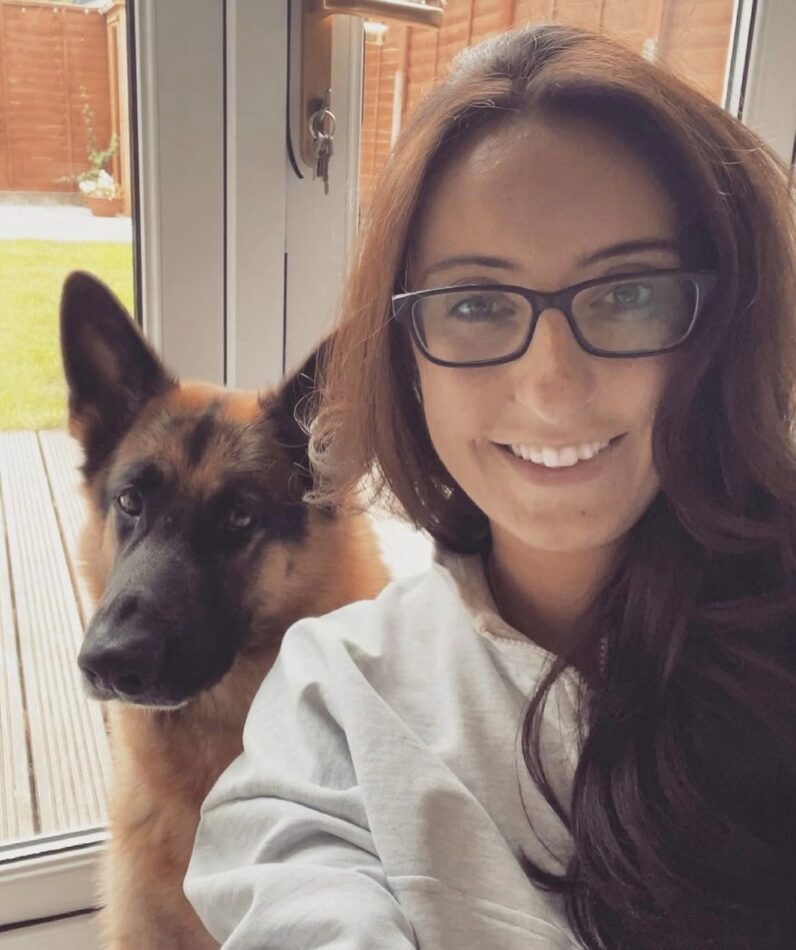
Canine behaviourist, Nikki Mather, explains our dogs’ adolescent phase and provides useful training advice on how to work through this stage successfully. Nikki, founder of Positive Steps Dog Training, is a qualified, force-free dog trainer (IMDT) and behaviourist (BCCS), predominantly working on cases including dog reactivity, separation anxiety and fear/anxiety-related behaviours.
Most new puppy guardians prepare well for bringing home a new puppy, from toilet training to mouthing to sleeping through the night. And, just when you feel like you’ve mastered this stage of your puppy’s life, they turn into a teenager!
The teenage phase is a testing period of your puppy’s life, bringing new challenges and frustrations to you as a dog guardian. During this time, your dog may seem like they are purposely ‘ignoring’ your requests, they may become a little more anxious than before, or they may completely fly off the handle – but let’s take a look at what is really going on for our pups during this stage, as well as training tips to help you navigate this challenging time.
What is adolescence in dogs?
The transition from puppyhood into an adolescent “teenage” dog can happen anytime from around 6 months, lasting until your dog reaches anywhere between 18 – 24 months. During adolescence, dramatic hormonal changes take place within your dog’s body, resulting in a rewiring of their brain.
During your dog’s teenage months, you may notice an increase in their confidence, becoming increasingly motivated to explore and interact within the external environment. Alternatively, your once seemingly confident pup may begin to exhibit more anxious, fearful behaviour. Regardless of the change, it’s important to remember that although older, your pup still lacks the experience and skill set to appropriately navigate our world and, therefore, is sometimes unable to rationally manage their emotions and reactions.
Behavioural changes you may notice
1. Increased anxiety (and therefore reactivity)
Most new puppy guardians are well aware of the importance of appropriately socialising your pup between 8-16 weeks. However, most aren’t aware that our dogs enter into a second fear period generally between 6-14 months.
During this stage, you may notice your once confident pup has become a little more anxious and fearful, which could result in an increase in reactive behaviour towards external triggers they once may have been comfortable around, such as people and other dogs.
In order to work through your dog’s second fear period successfully, it is important to continue their socialisation training to ensure they are continually exposed to triggers at their pace. This will help continue to build positive associations that will create the foundations of a well-adjusted, confident adult dog.
2. Regression in training
We’ve all been there – we bring home a little puppy and immediately begin working on their loose lead skills and recall training. All goes seemingly well…our pups don’t want to leave our side so their lead work is perfect, their recall is second to none and they hang onto every word we say!
Then, the teenage stage hits, and it feels as though everything goes out of the window and our young dogs know nothing!
You’re not alone in this – ‘regression in training’ is completely normal. During the adolescent months, our dogs’ hormone levels change, and they can become much more confident in themselves and their environment. You may notice they listen to you less, they run over to distractions outdoors and they don’t come back when you ask – super frustrating! During this stage, our dogs are often conflicted when asked to do something, driven predominantly by their uncontrolled impulses.
When you begin to notice this regression, don’t panic! You just have to go back to basics in your training – in other words, you need to make it easier for your dog! This might mean you go back to working with a long training lead when teaching recall, or you may give your dog a little more distance from distractions to help them focus on you more. Take the time to work through your dog’s regression, training at a pace they can handle, and you’ll come out the other side with an adult dog that is an absolute dream to have!
3. Ignorance!
During your dog’s adolescent phase, you may become increasingly frustrated by how much they are choosing to ignore anything you ask of them – you may even call this stubbornness! Whilst this may seem like your dog is actively choosing to defy you, it is more effective to try and understand where this ‘ignorance’ has come from.
When they were pups, YOU may have been the most exciting, rewarding thing for them. Now that they’re a little older, their motivators and preferences will change, and you’ll need to up your game in order to keep their attention in a stimulating world.
To do this, you can try using high-value treats to reinforce behaviours you like, such as fresh meats, doggy pate or cheese (within moderation). You can also use chase toys, tug toys or balls to better engage your dog and reward behaviours you like. The more you reward a behaviour, the more likely that behaviour will be repeated!
4. Increased energy levels
As a pup, your dog will have needed around 16-18 hours of sleep per day. Now that they are a teenager, their sleep requirements will reduce, so they may become more active around the home for longer periods of time (more time to get up to mischief!)
Now more than ever, it is important to ensure you are meeting all of your dog’s needs, including physically, mentally, socially and breed-specific. Consider the quality of your dog’s walks, how often do they engage their brain in stimulating activities such as sniffing and problem-solving, do they have ample opportunities to engage in play with you and other dogs (when suitable), and are their breed-specific needs to chase/dig/search etc. being met?
If your dog is restless and exhibiting unwanted behaviours, there is probably an unmet need that needs to be addressed!
5. Nuisance behaviours
The adolescent developmental stage is when most young dogs begin to show troublesome behaviours, such as excessive barking, jumping, lunging, destruction or biting/nipping. Such behaviours are typically a result of your dog working through some pretty big emotions, frustration sometimes making top of the list.
If you notice your dog showing unwanted behaviour, ask yourself WHY? There’s always a function behind our dog’s behaviour – is there something they want, is there a need not being met, are they bored, tired, frustrated etc. Once you understand why the behaviour is occurring, you’re better equipped to implement efficient training solutions!
Quick tips to help satisfy your adolescent dog:
- Let them sniff on their walks as this will tire them out mentally.
- Provide indoor mental stimulation such as enrichment boxes, snuffle mats and treats rolled into a towel!
- Balance high-energy activities with brain work-outs e.g. 5 minutes ball throwing followed by 10 minutes sniffing to help reduce adrenaline.
- Ensure you’re engaging with them through games, training or just cuddles – our dogs are social creatures!
- Teach them how to settle using a settle mat and ensure they have a quiet, undisturbed space to relax around the home.
Remember, your dog’s adolescent period will not last forever. Be patient and guide them into making more appropriate choices to help them co-exist peacefully with you. ‘Bad days’ are inevitable, but your hard work and consistency will pay off, and the relationship you’ll build with your dog along the way will be the most rewarding of all.
If you’re struggling and would like some professional help, please do get in touch with us at Positive Steps Dog Training.
This entry was posted in Dogs
Golden retriever puppies are undeniably adorable with their fluffy coats and playful personalities. But there’s one thing that can drive their pet parents crazy: their propensity to chew on everything in sight. From shoes to furniture, these pups seem to have an insatiable desire to gnaw on anything they can sink their teeth into. But why do golden retriever puppies chew so much? And, is there anything you can do to stop them?
Let’s get to know the goldens
Sweet, loyal, lively and incredibly good with kids – it’s no wonder golden retrievers are one of the most popular dog breeds in Australia. But what makes this breed so, well, golden? Let’s go back to the 19th century when they were first bred to find out.
In 1868, Lord Tweedmouth of the Scottish estate of Guisachan was interested in sporting and hunting dogs and finding one that could handle the Scottish climate and terrain. After failing to find any existing breeds that could keep up, he decided to create his own. By breeding a flat-coated retriever with a tweed water spaniel, Lord Tweedmouth helped create what we now know as the beloved golden retriever.
As seen in their medium to large size stature and solid, athletic build, the golden retriever has the sporting and retrieving genes all through their DNA. Coupled with their high canine intellect and effortless ability to learn commands, it’s easy to see why the golden retriever has long since been known as the preferred dog for hunting.
But even though the sport has been domesticated out of the golden, the instinct to catch and carry is still strong in this breed. Hence the reason these dogs, especially as puppies, like to put everything in their mouths.
Do all puppies chew?
Puppies use their mouths to explore the world around them, so it’s fair to say that there’s a method behind the madness (and destruction) of this natural behaviour. Here are some of the reasons puppies chew.
- Stress relief: Puppies, in particular, use their mouths to help them cope with stress. And when they come home with you, dog separation anxiety can continue when they see you leave the house or even just the room. Chewing helps to soothe their anxiety and provides a source of comfort.
- Pain relief: Chewing is also an essential part of a puppy’s teething process. As puppies grow, their baby teeth fall out, and their adult teeth grow in. This can be a painful process, and chewing helps alleviate discomfort by massaging the gums and providing an outlet for the growing teeth. It’s not uncommon for puppies to chew more during this time to seek pain relief.
- Exercise relief: All puppies require plenty of exercise and stimulation to keep them happy and healthy. When they don’t get enough run and play time, puppies can become bored and restless, and chewing becomes a way to alleviate that boredom. Providing plenty of dog toys, exercise, and attention can go a long way in curbing unwanted chewing behaviour.
- Communication relief: Dogs don’t speak human. So in order for them to tell us something, they have to find a different way to communicate. Puppies use chewing as a way to signal to their owners that they need help, are frustrated, or just want some attention. By observing your puppy’s body language and chewing habits, you can better understand what they are trying to communicate so you can respond accordingly.
Thankfully, chewing is predominantly a puppyhood behaviour and should subside considerably with age. If you notice that your older puppy or teenage dog is still chewing things around the house once they are out of this stage, it may be time to visit your veterinarian to make sure there are no underlying causes.
How do you stop a golden retriever puppy from chewing?
The short answer is you don’t. Chewing is a natural part of puppyhood, no matter the dog breed. But, there are ways you can redirect this destructive habit so your puppy can find healthier outlets for their instinctual behaviour.
Not all chewing is created equal
While it’s natural for golden retriever puppies to chew, it’s important to make sure they are chewing on appropriate items. You don’t want your new shoes, your favourite piece of furniture or even worse, their own dog bed to become your puppy’s new chew toy.
One of the best things you can do is provide your puppy with plenty of appropriate chew toy options. Look for toys that are specifically designed for puppies, as these will be softer and gentler on their developing teeth. You may also want to try a variety of textures and shapes to see what your puppy prefers. The more they chew their toys, the safer your furniture will be.
Smart dogs need stimulating
Golden retriever puppies are clever dogs, and they need plenty of opportunities to learn and explore. So one of the best ways you can try and curb your golden’s chewing habits is by increasing their exercise habits.
Keeping in mind that puppies are still not able to manage hour-long walks at these young ages, you can still keep them active during wake times with short walks around the block, energetic games of fetch or even just a stroll around the backyard to get lots of sniffs for mental stimulation. When it comes to puppies and chewing, it’s good to remember that a tired puppy is a happy puppy. And tired puppies are more likely to sleep in their bed than chew it.
Puppy patience
It’s essential to remember that golden retriever puppies are still learning and exploring the world around them. They’re not intentionally destructive or trying to be difficult. Instead, they’re simply trying to understand their surroundings and find their place in the world. By providing plenty of love, patience, and training, you can help your golden retriever puppy learn appropriate chewing behaviour and become a happy, healthy, and well-behaved member of your family.
The best bed for a golden retriever puppy
When it comes to choosing the perfect dog bed for your perfect golden retriever puppy there are a few important factors to consider. First and foremost is the size. Puppies grow…fast. So you want to get a dog bed that’s large enough to accommodate their growing body and give them the comfort to stretch out at any age.
But even more important than size is the durability of the dog bed. Did we mention that golden retriever puppies like to chew? The best dog bed for a golden puppy is one that is made from high-quality materials that are not only able to withstand constant chewing, but easy to keep mess and muck free.
The
Topology Dog Bed, designed by Omlet, is a first-in-class dog bed that can confidently provide all of these needs for your golden retriever puppy. We recommend the
Quilted Topper, which is not only durable but super comfortable, machine washable and guaranteed to withstand puppy teeth.
Omlet and your golden retriever puppy
At Omlet, we believe puppyhood is one of the best hoods to be in. Yes, it comes with its share of frustrations and destruction, but the love and happiness you get in return is unmatched. As the ideators and new benchmark makers of the pet products industry, we’ve taken our expertise to the next level and designed dog crates, dog beds and every other dog product you need to keep your golden retriever and you happy together – and your furniture intact.
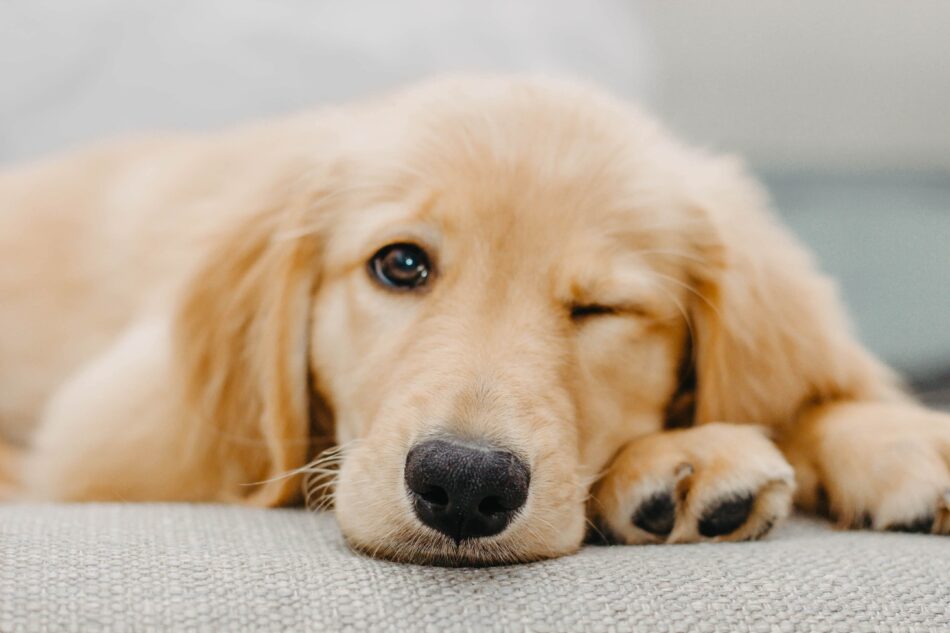
This entry was posted in Dogs
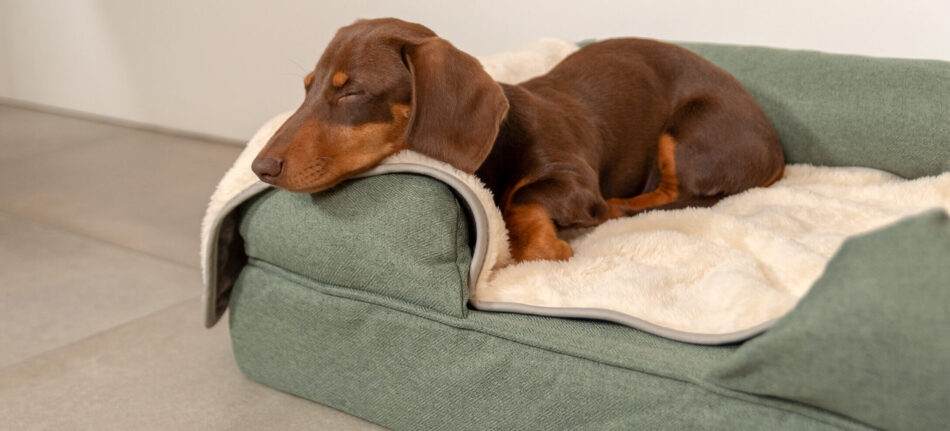
It’s no secret that dogs are smart, but with such intelligence comes an innate need to be stimulated. While your post-work weekday walks might occasionally seem a chore, our canine companions thrive when tested both physically and mentally, so finding activities to help bust dog boredom will prevent them from causing mischief. Here are some ideas to try and keep Fido out of trouble.
Bored dogs – spotting the signs
A bored dog is actually quite simple to spot. If you notice any of the following, then your pup could be trying to tell you they’re in need of more fun.
Destructive behaviour
Chewed-up shoes, gnawed chair legs and loose stuffing dotted around your home… sound familiar? Destructive dog behaviour is frustrating, but behind it all, the cause is often boredom. But with no other outlet for their emotions, dogs often turn to destroying your and their own property.
This being said, some behaviours, such as chewing, are also associated with canine anxiety, as well as puppyhood, which you can read about in our previous How to redirect your puppy’s chewing blog.
Whining and woofing
Notice your dog whining and woofing a lot more than usual? It’s not unusual, especially for certain dog breeds, to make a lot more noise than others, but if you see that it’s becoming more relentless with no apparent reason, this could be another sign of boredom after you’ve ruled out any illness or injury.
Getting dizzy?
Watching Fido chase their tail might initially be entertaining for us to watch, but if your dog is doing so obsessively, this could indicate an underlying problem. In younger dogs, this behaviour is most likely nothing more than a playful pup discovering what that thing attached to them is! But, if you suspect your dog’s tail-chasing is becoming a habit, contact your veterinarian. Should there be nothing of concern, you could simply have a bored canine who needs a little more attention.
Persistent pacing
Restless dog behaviour can include pacing. If your dog is going up and down your home in a frantic manner on a regular basis, then boredom could be to blame.
Off I go!
Got a Houdini hound on your hands? A dog that is frequently attempting to, or successfully, running away from home could be off to find entertainment elsewhere. Losing sight of your dog is a terrifying experience for any owner and when you’re providing such a loving home, it can be puzzling as to why they’d want to leave. Fortunately, most will find their way back and it’s important never to direct your frustration at them. Rather, see this as an opportunity to provide some more stimulation.
Commanding attention
Other than whining and barking, dogs can seek attention in any other way they know that will get their owners to make a fuss (even if it means when they’re getting into trouble!). This can include pawing and nudging, jumping up at you, dropping a toy on your lap and even stealing your favourite pair of shoes. A bored dog is a needy dog, so making sure you provide them with enough stimulation is key to putting this behaviour to bed.
Boredom-busting solutions
Now you know what to look out for, here’s how your furry friend can be on their way to living a more fulfilled and happier life.
Get digging
Dogs love to dig, especially terriers such as the Border terrier, Jack Russell and fox terrier. But, finding them digging up the garden isn’t so fun for us. Instead, encourage their digging instincts by creating a digging box they can use inside the home. All you need is a cardboard box, some scrunched-up paper and a few of their favourite treats to bury inside. Or, you can even use a dog ball pit, hiding treats at the bottom.
Fido fit for purpose
Working dog breeds were originally bred to take on tasks such as guarding, herding and retrieving. Huskies, for example, were bred as sled dogs, while the Bernese Mountain dog was bred as a working farm dog to drive cattle and guard the farm from predators.
Today, many breeds are kept as loving family pets, so it’s inevitably not possible for every dog to fulfil needs they were originally bred to meet. Enrolling them in an activity that resembles their intended “job” can help keep boredom at bay. Finding toys, hide and seek, rounding up toys and throwing their ball in the water to fetch are just a few fun activities you can incorporate into their routine, depending on your dog’s breed.
Back to school
They might have already graduated from puppy training but there are plenty of groups available for adult dogs. This could be further sessions to brush up on their tricks or even agility. If you’re not sure that a class is right for your dog, you can also set up a dog obstacle course of your own at home.
Doggy brain training
With their intelligence akin to that of a child between 2 and 2.5 years old, dogs can really benefit from brain training as part of their boredom-busting routine. Brain training toys, which encourage them to locate their treats such as snuffle mats or Kongs are readily available or can be made at home.
You can try using a muffin tray filled with tennis balls and treats hidden underneath. Or, why not use a few empty yoghurt pots or cups for them to work out which one the snack is under?
Pup playdates
Puppy play dates can be a great way for your dog to exercise. Perhaps you have a friend with a similar-sized dog that gets along with yours, or you can even join local groups of like-minded pet parents. But before you go ahead and unleash your dog, be sure to read our advice on how to make your dog’s play date a success.
Rethink your route
The same scenic stroll might be enjoyable for you but it’s important not to forget that a walk is for everyone involved – Fido included. Exploring a new walking route will give your dog new territory to explore with their nose and also the opportunity to try out training in another environment.
Alternatively, you can even try changing up the pace of your walking or letting your dog lead you. While letting your pup take the lead isn’t a habit you want to fall into, especially for lead pullers, occasionally allowing them to choose where they want to go can be a good way to switch up walks.
Omlet and your dog
And after all that exercise, what better for your pooch to relax than on an ultra cosy Bolster dog bed? A tired dog is a happy dog after all. Continue to discover the wondrous world of Omlet with our range of other dog products such as our dog crates that double as furniture and cosy dog blankets.
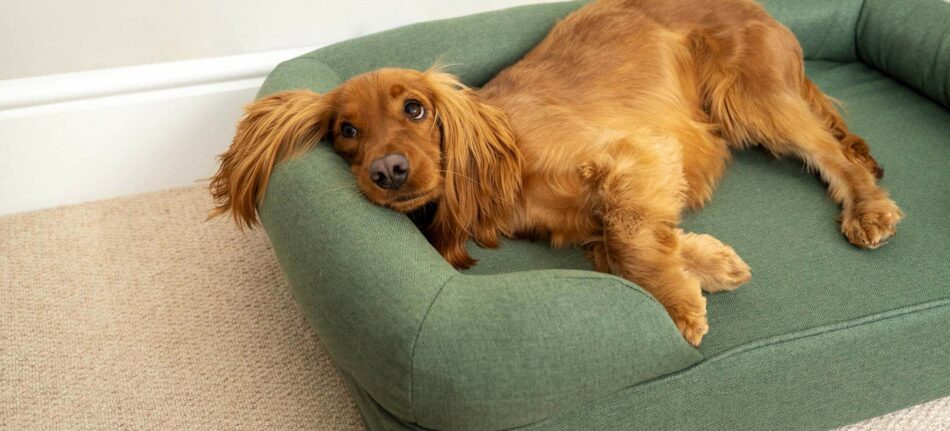

This entry was posted in Dogs
Rachel Spencer is a freelance journalist specialising in writing about pets and the pet industry and an award-winning pet blogger.
She welcomed her first rescue dog Daisy, a terrier cross, into her life in 2009, and this inspired her to start The Paw Post pet blog, writing about animals and the difference they make in people’s lives.
Rachel rehomed her second terrier, Patch, in 2018 and together they enjoy travelling to dog-friendly destinations and trying out the latest in doggy toys, treats and technology.
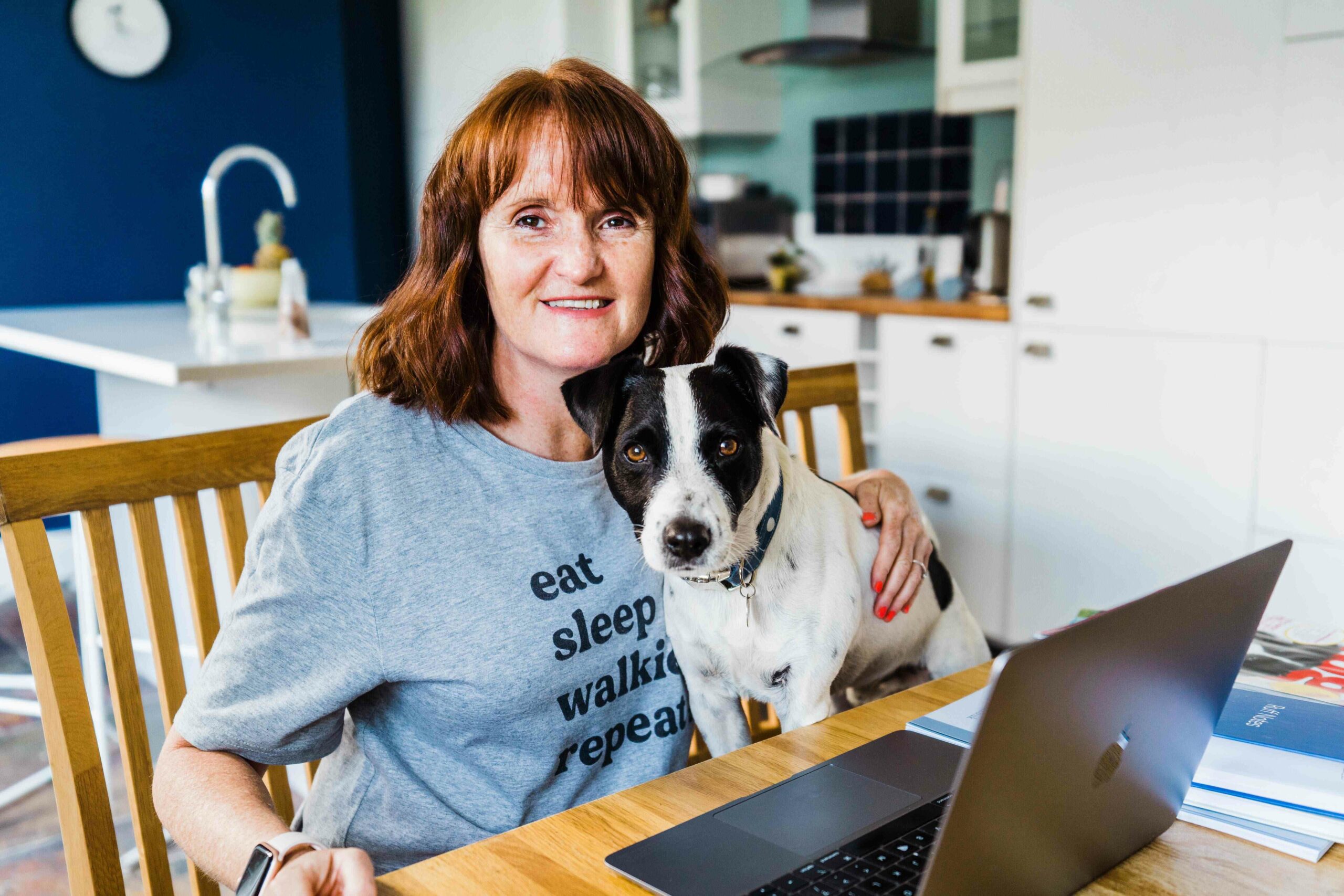
Welcoming a rescue dog into your home and your heart is a wonderful thing to do. You gain a faithful companion to give you unconditional love, and your dog gains a second chance at happiness. As a new pet parent, it’s key that your dog settles in your home and these seven tips will help you establish a routine.
1. Buy the basics
Stocking up on the following items ahead of your furry friend’s arrival will help them feel right at home.
- Food – ask the rescue or former owner what they are used to eating.
- Food and water bowls
- Collar, lead and tag with your contact details on – you’re legally required to include your name and address on and consider your phone number too.
- Toys
- Bed and blanket – the Omlet Topology Luxury dog bed is ideal, with washable and removable toppers and the option to pop a blanket over the top.
- To help your dog settle, snuggle under the blanket before they arrive so it carries your scent.
2. Give them space
Welcoming a new furry family member is exciting, but they will likely be tired and a little overwhelmed. They might be shy at first too, so be patient. Given time, they’ll interact and become more confident and playful.
They’ll need some peace and quiet so set up their bed or a crate, treats and a toy in a quiet room or area so they can retreat if they need some time alone.
3. Start exploring
For the first few days, take short walks in your local area and allow your dog to sniff and explore their new surroundings.
Avoid busy places with lots of dogs and leave their lead on to ensure they’re safe, then build up to longer walks in new places.
4. Monitor their progress
Consider keeping a doggy diary, so you can record how they settle in, their likes and dislikes, training progress and behaviour when left alone.
Rescue dogs may experience separation anxiety, so consider using a pet-cam to watch how they react when you leave them.
5. Connect with local pet professionals
Book an appointment with your local vet for regular checks, worming and vaccinations. This will help your pet get accustomed to the vet.
If they require regular grooming, you could also visit your local salon with your pup to discuss their grooming routine. During these visits, feed your dog treats to make it a positive experience.
6. Begin training
Dogs love to learn. Find a local, accredited, force-free trainer to teach you kind and ethical ways to communicate and bond. Choose from classes or one-to-one for professional guidance, and a chance for your dog to meet other dogs.
7. Look forward to years of happiness
There is a wonderful quote from psychologist Emma Kenney, “Opening up your life to a dog who needs a home is one of the most fulfilling things you can do.”
Whatever their past, your rescue dog can look forward to a new life by your side, from walks in the woods to cuddles on the sofa. By taking these simple steps to help them settle, you’ll be paving the way for shared adventures for years to come and a lifelong bond that’s hard to beat.
This entry was posted in Dogs
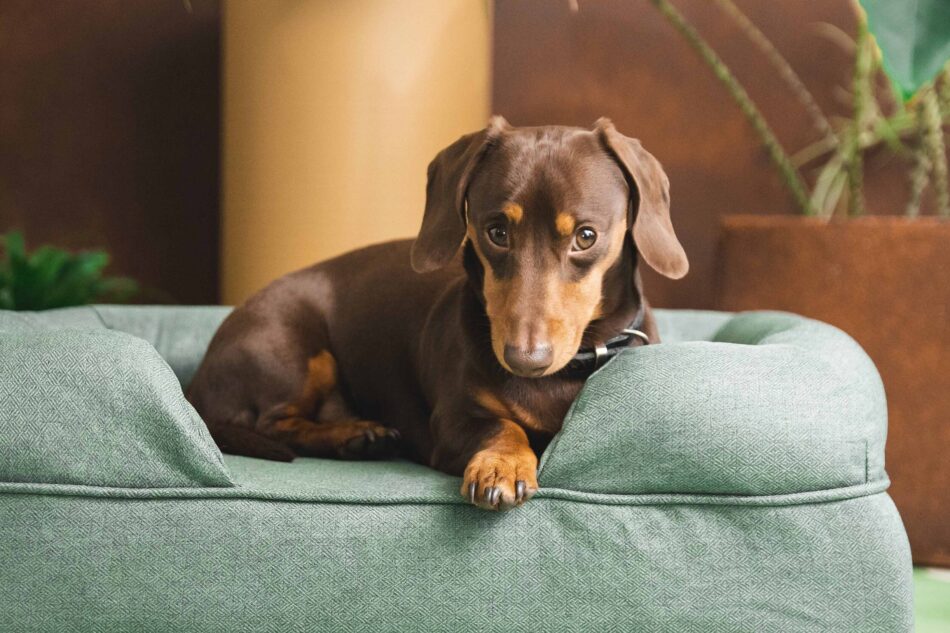
Springtime is nearly here, and as we leave the chillier days behind us, we can look ahead to everything the upcoming season brings. This time of year also marks the perfect occasion for new beginnings, with home renovation projects at the top of many lists of things to start on. Whether you’re doing a full house makeover for spring, or picking up the paintbrush for a wall refresh, your dog’s furniture should get a thought too. Discover your dog’s next and last bed to suit your spring decor with Omlet’s Bolster bed.
Meet your match
Omlet’s Bolster dog bed is available in 15 striking colours. Plus, choose from a range of 9 chic dog feet options to elevate your home decor to another level and improve home hygiene. So, which Bolster bed colour is best suited to your and your dog’s springtime retreat?
Subtle spring tones
If a subtle look is how you’re envisioning your home this spring, then Omlet has the dog bed for you. Our calming Merigune White Bolster design works great at creating a relaxing atmosphere to welcome in the new season. Or how about the Stone Grey Bolster dog bed to suit a neutral interior?
Worried about cleaning muddy pawprints? Omlet’s Bolster dog beds are super easy to clean, with a removable, machine-washable cover that means beds get back to looking brand new in just one gentle cycle.
A pop of green
Add a pop of green to your home with either the Matcha Green, Sage Green or Light Jade designs. These stylish shades are the perfect nod to spring as the luscious greenery makes its appearance again. Plus, these beautiful designs look fantastic paired with any of our sophisticated gold feet options.
Be bold
Inspired by the brighter colours of spring? Opt for the Mellow Yellow or Cherry Red Bolster bed. These bold colours are bound to command attention and look great within a maximalist-decorated home.
Accessories to suit
Whether you’ve decided on a chic Light Jade or bold Mellow Yellow to incorporate into your spring decor, you’ll need accessories to match. As we transition into the new season, we still have a few cooler days ahead and the remaining chilly nights still call for you and your dog to wrap up warm. Our Super Soft Dog Blanket is excellent for just that, offering comfort and style. Switch from a luxury sherpa material to a charcoal grey or poinsettia red quilted plush on the reverse, all while protecting your furniture from dirt and debris.
As the weather warms up, switch out your dog’s blanket for a dog cooling mat to keep temperatures down. Our cooling mat slots right on top of our Bolster dog beds, meaning that your dog will still be able to enjoy the premium cushioning from their bed, whilst staying cool. The sleek design of the cooling mat also means you’ll subtly be able to fit it in with the rest of your brand-new spring decor.
Memory foam support
Having a dog bed that looks great is one thing, but one that does great too, is another. At Omlet, we know the importance of getting both just right, which is why our product designers carefully crafted a dog bed that does it all.
The deep, memory foam mattress of the Bolster dog bed offers unrivalled comfort for your dog – especially important for ensuring quality snooze time after those long walks. Exercising your dog all year round is key to ensuring your four-legged friend is physically and mentally stimulated. But, we also understand that darker, shorter and colder days of winter mean that it’s not always possible to get out for those extra-long walkies. Now that spring is upon us, though, it’s the ideal time to spend more time outdoors with your dog, making the most of this wonderful climate. And what better than a memory foam cushioned dog bed for Fido to rest their paws on after a long springtime walk? The bed is ideal for older dogs or those with joint pain too, providing an extra layer of support.
Omlet and your dog
At Omlet, we’re pet people, which is why we continue to design solutions for our furry and feathered companions – and their parents. From super comfy dog beds that match your spring furnishings to cosy dog blankets or cooling mats to beat the heat, Omlet has created products to ensure you and Fido enjoy the rest of the year ahead.
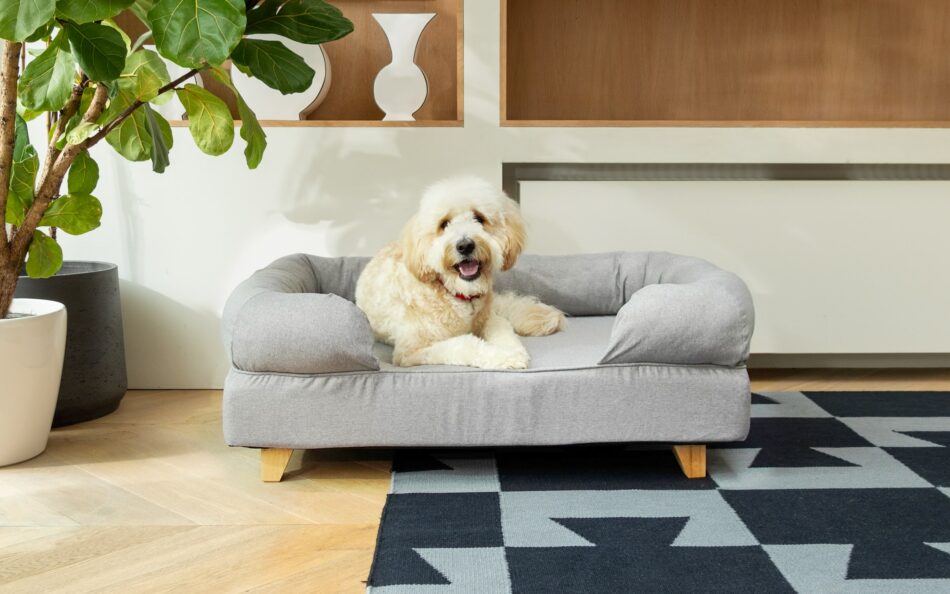
This entry was posted in Dogs
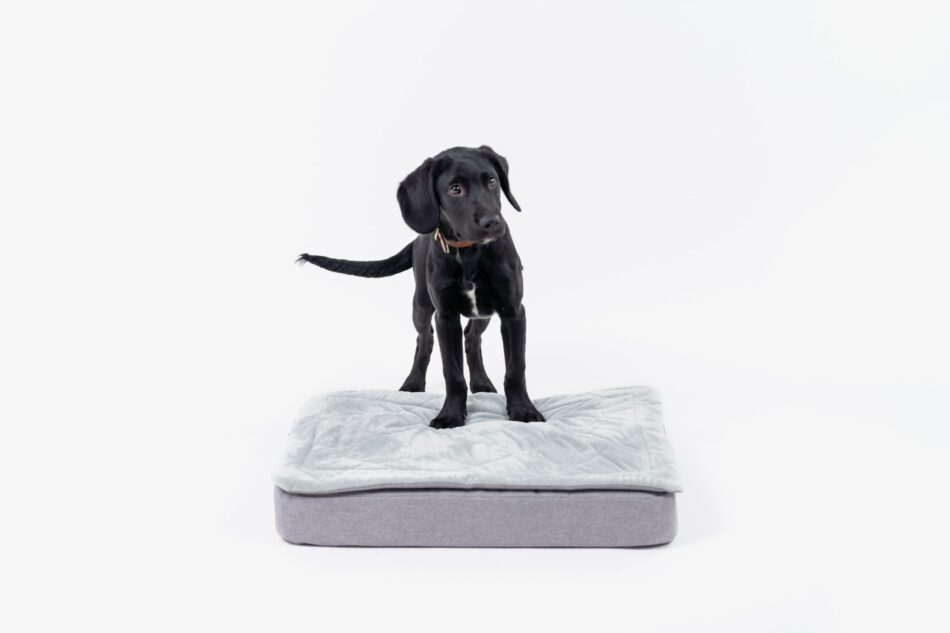
Choosing the right dog bed for your puppy can be tricky – or at least it used to be…Omlet’s Topology dog beds tick all boxes for your new best friend’s nap time needs, meaning you no longer need to compromise on what your puppy truly wants. Say goodbye to flimsy mattresses, chewed-up toppers and bad bed odours and discover why Topology is the perfect solution.
Comes in three different sizes
Depending on your dog’s breed, your puppy might be super small at the moment, but they’ll quickly grow up to be a full-sized dog before you know it. And since the Topology dog bed is the last you’ll buy, we recommend buying a bed based on their predicted measurements as a fully-grown adult dog. You want to make sure that your dog will be able to fit on the bed in all possible sleeping positions. The bed might look comfy when they’re curled up into a furry little ball, but would they be able to stretch out their legs if they wanted to? As they grow older you’ll find which positions they tend to sleep in, but for now, it’s best to go slightly bigger to be on the safe side.
The Topology dog beds come in three sizes to accommodate all breeds and are designed to fit snugly into standard-sized crates, avoiding any gaps along the sides. Just be sure that if you’re planning on dog crate training and want to put your bed in the crate, check your dog’s crate dimensions to ensure it fits. Take a look at our dog size guide so that you can match your breed to the right bed.
Choose from a range of removable toppers
The genius of the Topology design means that you can choose a range of versatile dog bed toppers which can all easily be removed to put in the wash, reducing odours and improving home hygiene.
For puppies, we recommend the Quilted topper, designed by Omlet with razor-sharp puppy teeth in mind. This super soft topper means optimum comfort for dogs of all ages and the durable fabric with the option to zip a puppy pad underneath, makes this style perfect for growing dogs.
Whilst your Quilted topper is being washed clean, you can choose an extra topper to zip onto your Topology dog bed. The Sheepskin topper is ideal for smaller puppies that might need a bit of extra warmth, transforming their bed into a cloud of tranquillity. Plus, you can pick from five different colours of this luxurious topper to match your home decor.
Minimise chewing damage
All puppies will chew – there’s no way around it. Dog breeds such as Golden Retrievers that are bred to use their mouths to fetch and carry are more likely to destroy anything that comes in their way, as well as breeds with a high prey drive.
You can of course train your puppy from an early age to only chew appropriate dog toys or other accessories, but if they do manage to get those sharp teeth into their bed, the design of the Topology dog bed means they’ll likely be unsuccessful in getting through the topper or mattress.
No need to worry about dirt and accidents
Puppies get into all sorts of mess, so being able to zip off the topper and put it in the washing machine will make your life a lot easier, and your dog will appreciate having a fresh bed to return to.
This goes for puppy toilet accidents as well. If there’s a leak, the mattress under the topper has a waterproof cover that you can easily remove and wash with the topper. If this becomes a recurring problem, you can even put a puppy training pad on the mattress before your zip on the topper to soak up any accidents.
Provide premium comfort
Puppies sleep up to 20 hours a day, and it’s super important to give their growing bodies extreme comfort and support. Keeping your dog off the ground on a sufficiently padded surface can prevent severe arthritic pain in the future, so make sure you choose a good-quality bed.
Topology dog beds have a memory foam mattress that moulds around the body as the dog lays down on it, and provides amazing support for tired legs after vigorous play. The toppers all add extra comfort, either by super softness against the body, like the Quilted or the Sheepskin, or by extra padding like in the Beanbag or Bolster toppers.
Pick the perfect extras
If you decide not to place your puppy’s bed in a crate, you can elevate your Topology off the ground with a range of stylish feet. Raising your dog’s mattress reduces drafts and improves the airflow under the bed, which helps minimise a build-up of mould, mildew, dust and debris.
It’s also a good idea to add a blanket to the bed to make your puppy’s Topology dog bed for an even better night’s sleep. Simply place your Omlet Super Soft dog blanket on your puppy’s bed and they’ll soon learn to associate it with a safe and calm environment. This means that if you go away on holiday or have to take your puppy to the vet for their jabs, you can bring the blanket and give him or her an extra sense of safety.
Omlet and your puppy
We’re confident that your new puppy will love their Topology dog bed, and you can be confident knowing you’ll have a dog bed to last a lifetime. Plus, with accessories such as designer dog bed feet and super snug dog blankets, your furry friend will be sure to have their own puppy paradise for years to come.
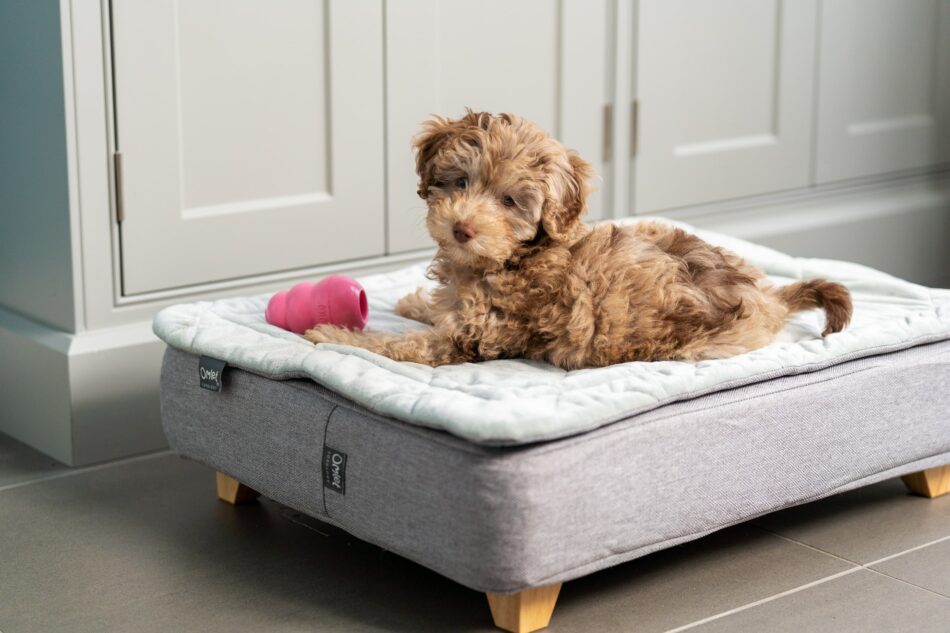
This entry was posted in Dogs
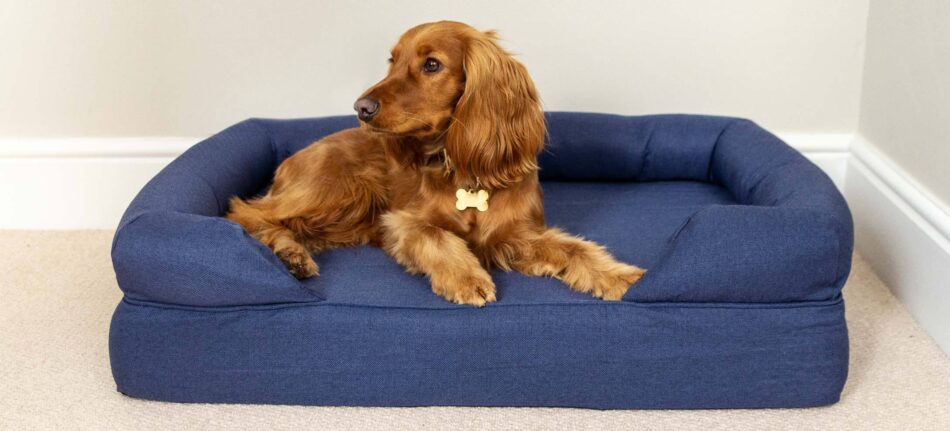
Our rescue dog checklist can help guide you to what to consider before adopting and the essentials you’ll need for your new pup. These four-legged furballs are superheroes in disguise who inevitably bring endless joy, love, and laughter into your hearts and home to create an incredible tail-wagging adventure. But before you embark on this journey, it’s essential that you are prepared for their arrival. In order to be the best rescue dog superhero parent, you need to have the best products. Let’s take a look at this epic rescue dog checklist that will ensure you’re ready to welcome your canine hero home with happiness.
Why rescue a dog?
It goes without saying that one of the best reasons to rescue a dog is to save a life. But did you know that by adopting a rescue dog, you’re not only saving the life of that dog, but another as well? When you bring a rescue dog home, you’re making space at the shelter for another rescue dog to take its place, in turn saving yet another life.
4 important reasons you should consider a rescue dog:
- Unconditional love: Many people worry about adopting a rescue dog because there are several unknowns associated with it. But the truth is, whether you get a new puppy from a breeder or a rescue dog from the shelter, there will be a lot of uncertainties for everyone. Rescue dogs have grateful hearts and an appreciation for their new life that is shown through unmatched and unconditional love.
- More exercise: No matter what dog breed you rescue from a shelter, all dogs need exercise. And as their new pet parent, you just became their exercise companion. Whether you’re looking to lead a more active lifestyle or not, adopting a rescue dog means you now have the ability to get out and enjoy the great outdoors more often.
- Social outings: Dog people like to hang out with other dog people – it’s a thing. So when you adopt a rescue dog, you’re given the opportunity to interact and socialize with new people. Meetups at dog parks or dog-friendly restaurants are a great way to make new dog friends for your rescue and new human friends for yourself.
- Built-in bestie: What’s better than a lifelong friend that showers you with love and joy every time you’re around? That’s what it’s like with a rescue dog! A constant playmate, confidante, and snuggler, rescue dogs are not only your friend for their life, but they also become a beloved family member. Who could ask for anything more?
What to consider before rescuing a dog?
When it comes to rescuing a dog, knowledge is power. So before you dive headfirst into the furry adventure of pet parenting, there are a few things you should consider.
- First off, assess your lifestyle. Dogs, especially rescue dogs, require time, attention, and care. Are you ready to commit to walks in the rain, cleaning up hair and potential messes, and dealing with the occasional chewed-up shoe? Adding a rescue dog to your family needs to be a family decision so it’s important that all members of your household, two-legged and four-legged alike, are on board and ready to welcome a new member to the brood.
- Next, consider your living arrangements. Dogs come in all shapes and sizes, but small apartments may not be best suited for large dogs and large homes may have too much space for small pups to feel secure. Understanding different dog breed personalities and energy levels will also help you better decide which rescue dog would be the best fit for your family.
- Lastly, the financial obligations that come with rescuing a dog should be on your radar. Just like humans, dogs need the basics such as food, dog toys, and regular vet visits. But it’s important to factor in all costs associated with dog parenting so you are prepared for any unexpected costs that may arise. Just remember, owning a dog may be an investment in your bank account, but the investment you receive in love is far greater.
Choosing the right bed for your rescue
Finding the right dog bed for your new canine companion is an important step as it will quickly become both a sleep spot as well as a familiar friend. Keep in mind that many rescue dogs may be nervous or scared during their first few weeks in their new home, so having a comfortable dog bed that gives them a sense of security can make all the difference.
Importance of supportive beds
The Bolster dog bed, by Omlet, is uniquely designed to create that sacred space that any rescue dog will love. The supportive cushioned surround emulates a safe, cosy spot where your rescue dog can retreat to if they’re feeling overwhelmed or shy. Or, they may just curl up there often because it’s so comfortable
And speaking of comfort, the Bolster Dog Bed is designed with a premium memory foam mattress that is luxuriously supportive. While rescue dogs come in all ages, many are in, or closer to, their senior years and may have more sensitive joints. The Bolster Dog Bed gives them that comfort assurance they need to rest on well into their golden years.
Easy-to-clean dog beds
But what you’ll love most about the Bolster Dog Bed are the customizable colour options and ease of cleaning. Choose from a variety of covers in different colours that best match your decor. When they get too dirty or smelly, simply zip it off and toss it in the washer for a like-new clean. Finally, a dog bed that every member of the family will love!
What else you’ll need for your rescue dogs
Once you have the perfect dog bed, you can add on to your rescue dog’s comfort with additional items to make them feel more at ease and settled in.
4 products to make your rescue dog’s homecoming the best one they’ll ever have
- Blanket: Your rescue dog will still be getting to know you during their first few weeks at home. And one of the best ways to create a strong bond with them is by allowing them to know your scent. Adding a soft dog blanket to your rescue dog’s bed not only gives them an added layer of comfort, but another way to get closer to you. Simply wrap the blanket around yourself before placing it on the bed so your scent stays with them always.
- Crate: If your rescue is showing signs of uneasiness, you can help them feel safer and settled by adding a dog crate to their routine. The Fido Nook, designed by Omlet, is a great option because it feels less like a standard wire crate, and more like a personalized home within a home. You can even place their dog bed directly into the nook to create the ultimate rescue retreat.
- Dog bowls: With meals served 2-3 times a day, the dog bowls your rescue eats out of are important. Make sure you buy one that is easy to clean and sturdy – neither you, nor your rescue wants spilled food at dinnertime.
- Dog toys: One of the best parts of being a rescue dog parent is getting to spend time playing together. And while walks outside or in the park are super important, nothing beats the one-on-one engagement that comes from playing with your dog. So be sure you have plenty of dog toys on hand so you and your superhero hound can spend lots of time getting to know each other better.
Omlet and your rescue dog
At Omlet, we value the bond between pet parent and pup above all else. We create our products based on our own personal pet parenting experience and understanding of not just what your pets need, but what they want. And rescue dogs are no different. Our Bolster dog bed will welcome your new canine companion home with comfort and ease and allow you to focus on what matters most – connecting with your new best friend.
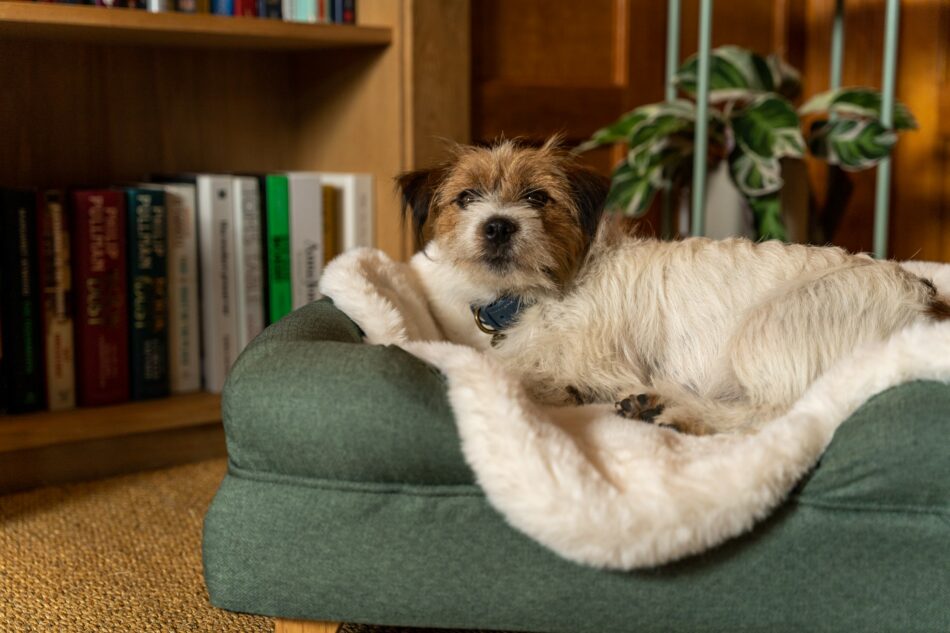
This entry was posted in Dogs
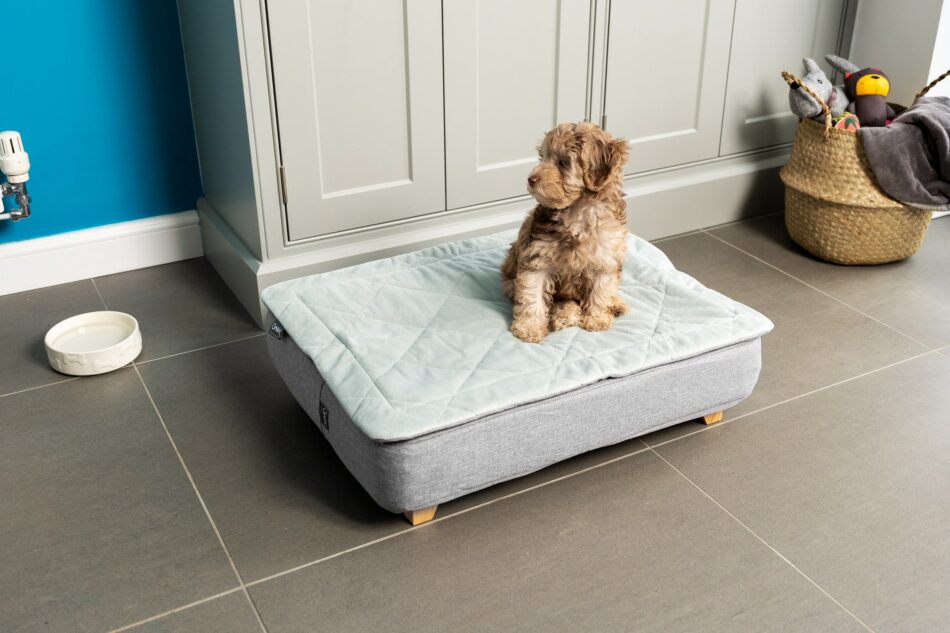
It’s true that dogs can sleep pretty much anywhere! But, when you think about it, so can we – in a tent, on a long train journey, or in front of the TV. However, by choice we would prefer to be tucked up in our own comfortable, warm beds, waking up feeling refreshed and as though we’d had a good rest, rather than grouchy and with a crick in the neck. Dogs are just the same, which is why it’s so important for us to provide our pups with the bed they deserve.
The Importance of a good dog bed
Provides your dog with a better night’s sleep
If your dog is comfortable in their own bed at night, this inevitably goes hand in hand with them having a better-quality sleep. Just as it is to me and you, sleep is crucial to our furry friends for a number of reasons. A good night’s sleep helps with your dog’s brain development, immune system, as well as with their mood. Who said that it was just humans that got grumpy after getting out of the wrong side of the bed in the morning?
Security
Dogs are territorial animals, meaning that they like to claim certain places as their own, with the areas they deem the “most special”, i.e. where no one else should go, the most important parts of their territory. For many dogs, this special place is their bed, where they should be able to comfortably lie and relax in peace, without being disturbed by any other members of the family – the ultimate safety zone for your pet.
However, one mistake that some dog owners make is to send a “naughty dog” to their bed as a punishment. Needless to say, this creates a negative association with the bed for the poor dog, which of course will not make them feel as though their bed is somewhere they can feel safe.
Something else to note here is if you have more than one dog in the household. Your dogs will usually insist on having their own, separate sleeping arrangements, so it’s fundamental that one dog’s bed is not treated to the canine equivalent of sofa surfing. A dog that shows interest in another dog’s comfy mattress should be firmly discouraged.
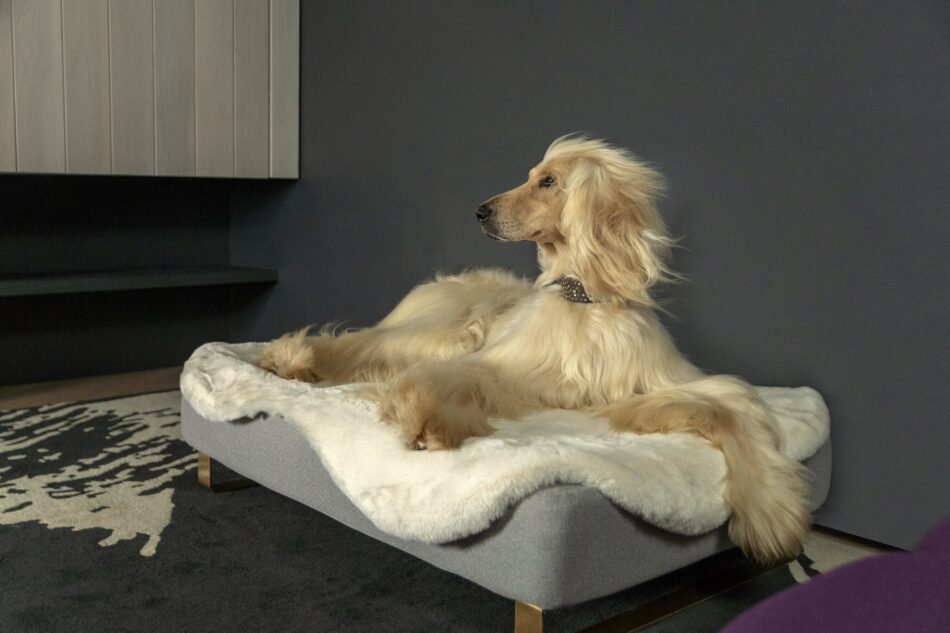
Supports joints
If you don’t provide an actual dog bed, your furry companion will improvise. A favorite spot on the rug, on the chairs, a comfy corner away from all the noise, or an old towel or blanket. These can all be roped in as beds, and the dog will retire there whenever he needs some downtime. However, the problem with this is that it could actually be having a negative impact on their joints.
As a dog gets older and their joints become stiffer, it will appreciate the comfort of a good dog mattress even more so. Older dogs especially are prone to suffering from joint issues such as arthritis and hip dysplasia, with certain larger breeds such as German Shepherds and Great Danes being more susceptible to these than others. A high-quality, memory foam dog bed like the Topology from Omlet will help keep your dog’s joints supported, by minimizing stress and preventing any unnecessary muscle pain. Dog beds can also prevent sores, calluses and bald patches – all things that may affect dogs who sleep on wooden or stone floors, or rough carpets.
Encourages your dog to sleep in their own bed
The spot your dog chooses, given half a chance, may be your own bed. Unless you’re firm with him, he’ll be there to stay. In a previous blog, we discussed whether it was a good idea to let your pet sleep on your bed at night. While it was agreed that there are some benefits of doing so, this may not be the appropriate scenario for everyone. In this case, providing your own dog with a comfortable bed will work out in your favour even more so, encouraging them to sleep there as opposed to in yours. This is yet another reason why buying a comfy dog bed makes sense.
How Omlet supports your dog
Sleep is one of the most important parts of your dog’s life. At Omlet, we asked how we could support this essential need and then got to work designing. We engineer all of our dog beds with high-quality comfort, superior support and detailed qualities that enhance your dog’s health and happiness. And with our range of dog beds we even found a way to make boring beds beautiful. Supporting your dog’s sleep isn’t just a product we make. It’s a mission we take seriously to create what matters most for your dog that matters.

This entry was posted in Dogs
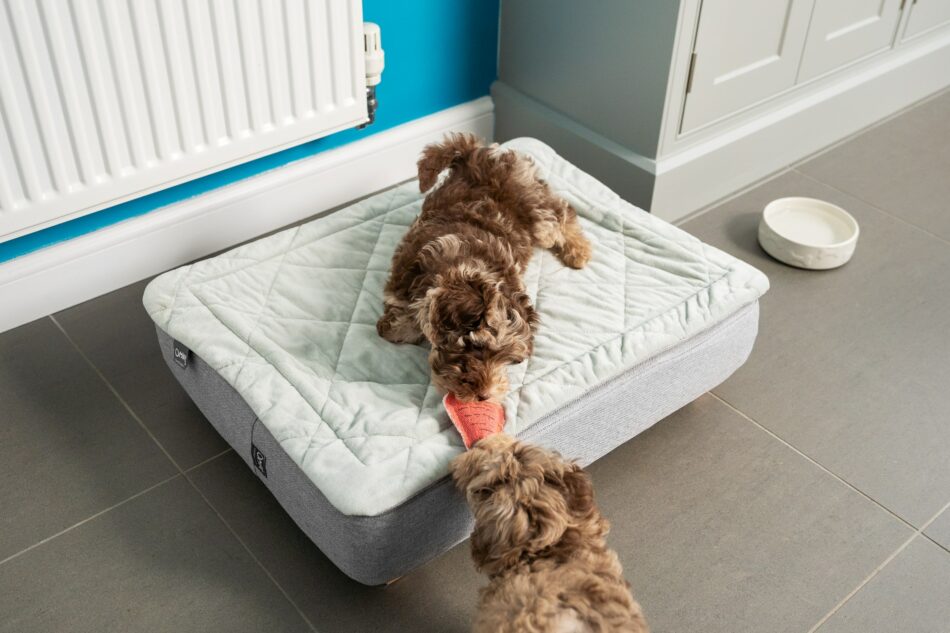
For puppies, the whole world is just one big chew toy. In order to explore their surroundings and everything in it, they use their mouths and teeth to chew through their curiosity. While this behaviour is extremely normal and expected, that doesn’t take away the fact that it can also be frustrating and destructive – especially to your furniture, shoes or even their dog beds. So if you’re a puppy parent wondering when the bite marks and chewed socks will end, keep reading. Omlet has the advice and products you need to help redirect your puppy’s chewing.
Normal puppy chewing behaviour
Just like babies, puppies experience pain and discomfort when teething. For the first 6 months of a puppy’s life, they spend much of their time chewing and biting as a way to help give their mouth and teeth some relief. It’s perfectly normal for puppies to chew as a way to strengthen their jaws, stimulate their brains and relieve anxiety – they literally can’t help it!
While some dogs can be mouthier than others, if you’re noticing your puppy chewing and biting excessively, there could be some underlying reasons to keep an eye out for. In Australia, most puppies can be adopted by a human family as early as 8 weeks old. However, sometimes these precious pint-sized pups are separated from their mother much earlier than they should, causing them severe separation anxiety and a heightened tendency to suck on fabric. As a result, puppies in this instance could display more chewing habits for longer periods.
In addition, puppies who are bored or not receiving enough attention once they are in your home could exhibit more chewing as well. But regardless if your puppy is a mild, moderate or mega chewer, this behaviour is only temporary and there are ways it can be redirected and eventually resolved.
Puppy-proof the house
The first golden rule of puppyhood that should be followed at all times is this – never leave your puppy unattended to roam free in your house. We promise it will lead to mass destruction! So the best thing you can do before you bring your puppy home is designate which room in the house will be the temporary puppy pad. We suggest a room with tile and not carpet.
The second golden rule of puppyhood is to remember to have patience. While the natural behaviour of chewing and biting can be redirected, it is a slow process that will take time and inevitably have many ‘slip-ups’ along the way. So be prepared to deal with several chewed-up socks, shoes and even dog beds.
Fortunately, Omlet has solutions as we know puppy chewing is nothing to be messed with.
Tips to redirect puppy chewing
While we do know that your puppy won’t be able to chew through their Omlet Topology Bed, we are certain that they will find something else to chew on. After all, puppies will be puppies. So here are some ways you can help redirect your puppy from chewing anything else in your home.
Did you know that puppies can get bored? Kind of hard to believe given their bubbly and inquisitive nature. But it’s true, and puppy boredom can lead to a lot more chewing. So the best way to combat this is with exercise. Because after all, a tired puppy won’t chew as much.
Just keep in mind that at their still very young age and susceptible systems, puppies can’t go on long walks or romps at the dog park. So finding ways to play with your puppy indoors is key to keeping boredom at bay. Any type of physical or mental stimulation will help alleviate the need for excess chewing.
Just as toddlers need lots of toys for added stimulation, so do puppies. So be sure you have several dog chew toy options on hand for your puppy to use. Just don’t give your puppy old socks or shoes as chew toy options – that will only cause confusion when they try to chew the new shoes left at the door.
You can also rotate chew toys every few days so your puppy has something new to clench their chew with. When selecting toys for your pup, keep their size and age in mind so that you choose ones that are appropriate for their specific needs.
How about taking those puppy chew toys to the next level with Kongs. These super hard plastic chew toys are a great way to redirect your puppy’s chewing. Designed to stand up to the sharpest of puppy teeth, a Kong toy is a great replacement for a shoe, sock or even a piece of furniture your puppy has become fond of.
As soon as you see your puppy chewing something they shouldn’t give them a Kong toy to chew instead. In time, they’ll pick the toy over the furniture. You can even stuff the Kong with one of these easy-to-make Kong recipes. Just make sure the ingredients are suitable for your puppy before serving.
What do you do if your puppy is more attracted to electrical cords instead of shoes for their chewing regularity? That can be dangerous! In the event you see your puppy going after cords or really anything that is an absolute ‘no chew zone’, you can use a repellent as a way to redirect.
Dogs hate the taste of anything bitter, so spray a bitter apple spray on the items that you want them to stay away from completely. Just make sure your spray is natural and non-toxic and it will be a safe measure to take in redirecting their chewing.
How NOT to redirect puppy chewing
It’s really important that you avoid any negative reactions or consequences as a way to redirect their chewing. You have a lifetime to look forward to with your new furry friend and if you try to stop their innate chewing behaviour the wrong way, it could lead to less trust later on. So here are a few tips on what not to do in redirecting your puppy’s chewing.
- Never place a muzzle on your puppy’s mouth
- Never try and clamp their mouth shut with your hand
- Never use a dog crate as punishment tool for chewing
Omlet and your puppy
As the experts on puppy behaviour, we know all too well how normal and frustrating the first few months of puppyhood chewing can be. That’s why our Omlet designers create products that are both beneficial and durable to withstand the power of puppy teeth. From a wide range of dog chew toys that are a perfect replacement for shoes and socks to our dog beds, which are engineered to go up against any good puppy chew session, Omlet has what you need to settle in your puppy.
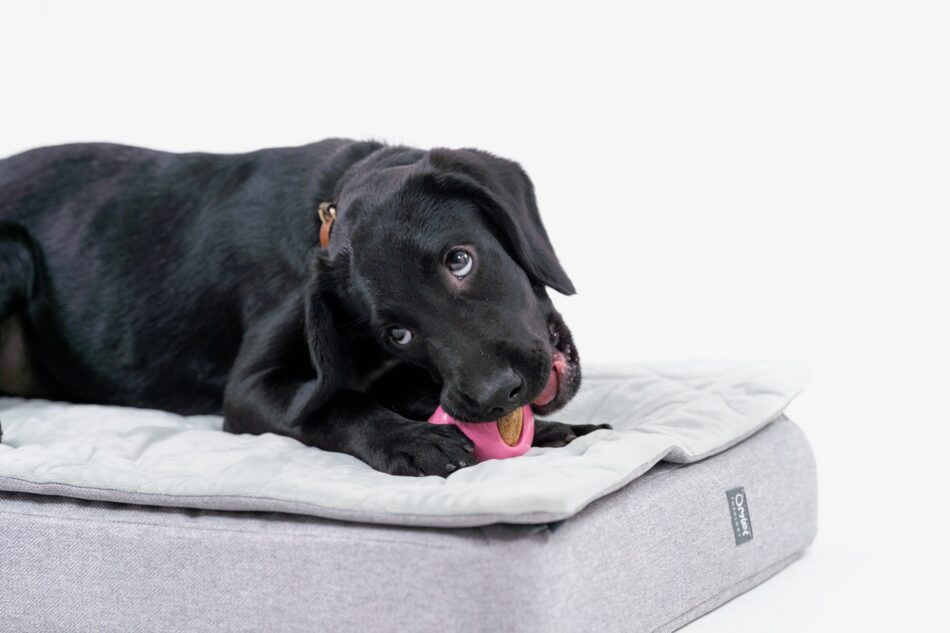
This entry was posted in Dogs

So you’ve added a new puppy to your family? Congratulations! Settling a new puppy into your life comes with all the highs of precious puppy snuggles as well as the lows of “Did they chew my shoes again?!” To help you make this transition easy, we’ve gathered everything you need to know on how best to settle in a new puppy. From simple steps to puppy products, Omlet has the advice you need to make the adjustment period smooth for everyone.
Puppy’s first 24 hours
Here’s the thing about adding a puppy to your family – it’s a lot of fun, but also a lot of work. Before you bring your new furry friend home for the first time, you need to make sure your home is prepped and puppy-proofed and that you have stocked up on all the new puppy essential products.
The first 24 hours at home can be an unsettling time for both of you. Everything is new to your puppy – your furniture, the space and even the smells are all foreign to your new bundle of joy. So it’s normal to expect lots of sniffing, pouncing and even some potty accidents. Likewise, you may feel a bit unsettled having a new living, breathing bouncing playmate running around. Especially if you have never owned a puppy or dog before.
While the first day together may feel uneasy or unfamiliar, fear not – it’s temporary and you both will start feeling settled in, in no time. Here are a few steps you can take in the first few weeks to make the homecoming less stressful and more enjoyable.
Introduce your puppy to their bed
Just like you have your personal bedroom where you sleep every night, you want to make sure you designate a spot in your home that is specific to your puppy as well. Having a familiar place to go to will allow your puppy to feel more comfortable and secure as they’re settling in.
The easiest way to create the perfect puppy place is with a dog bed. Not only will this be their spot for rest, but it will soon become their safe haven from any disturbances or distractions that might make them feel uncomfortable.
The Topology customisable dog bed designed by Omlet is the perfect bed for a new puppy as it will not only grow with your puppy into adulthood, but you can customise it to their needs along the way. Engineered with a solid base and superior memory foam mattress, the Topology offers a wide selection of toppers that are easily zipped on and off the bed. This not only allows you to pick a personalized topper from a variety of fabrics and colours, but it makes cleaning the dog bed as easy as one, two, zip.
Each topper is made from durable, hard-wearing materials so even the toughest of new puppy teeth can’t chew through them. Our recommendation for puppies is the Quilted Topper as the soft, plush feel will give them unbeatable comfort while also maintaining the strength to resist a hard teething session.
Keep visitors to a minimum
When you bring your new puppy home, it’s tough not to invite your mom, cousin, neighbour and even your local grocer all over to see your adorably cute new furry friend. But try to resist too many visitors over the first few weeks.
While socializing your new puppy is important, having too many visitors at once can actually become overwhelming and cause stress. So when it comes to meeting new friends, slow and steady is the best rule of thumb.
And when you do welcome visitors into your home, be sure your puppy has a safe place they can retreat to in order to feel secure, such as their dog bed or even a dog crate. Nothing makes a puppy feel more settled than the comfort of their own space.
Show your puppy where to go potty
Potty training your puppy is easy with these two simple steps: start early and be consistent. Whether you use puppy pads or the great outdoors, establishing a potty routine early on will make the process much easier on you both.
Keep in mind that your puppy is learning so much at this young age, so patience is key in potty training. Accidents will happen along the way, but with a regular schedule that starts the day they come home, your puppy will be potty trained in no time.
Let your puppy take it at their own pace
Having a puppy is kind of like having a toddler. Simple moments of playtime are filled with endless hours of excitement and it’s hard not to want to engage and play all day. But just like a toddler, all that play can make a puppy tired and knowing when to give them space is super important.
So make sure every family member is on the same page and knows how to give proper boundaries to the new addition. While it’s exciting to play with a new puppy, not all puppies want to play all the time. Every breed is different and your puppy will settle in at their own pace so long as you give them the space and time they need to do so.
Signs of a restless puppy
Imagine being transported to a completely new place you’ve never been to before and being surrounded by people and things you’ve never laid eyes on before. That’s exactly what it feels like for a new puppy when you first bring them home. All the new smells and sights can make a puppy feel restless but it’s important to make sure there are no underlying causes if the restlessness continues. Here are some signs of a restless, unsettled puppy:
Pacing
It is completely normal for your puppy to quickly traverse every room of your home during the first few days as that is how they learn about their surroundings. However, if you start to notice your puppy pacing back and forth in one particular area, this could be a sign that they are unsettled or even have some puppy separation anxiety.
When you notice this behaviour, try to limit your time away from home to frequent short getaways as opposed to long periods, if possible. And when you do have to be away for hours at a time, make sure they have a comfortable dog bed and dog crate where they can feel secure and comfortable.
Regularly waking up at night
In the first few weeks, puppy sleep is very similar to baby sleep – it’s sporadic. And while you can expect to be up a few times each night for the routine potty breaks, you want to make sure that your puppy can settle back to sleep easily for more rest.
When you start to notice they are up for more of the night than they are asleep, this could be a sign they’re unsettled. In order to help your puppy get their much-needed sleep, get them a Topology customisable dog bed so they can rest with comfort, support and ease.
Panting
Unlike humans, dogs don’t have sweat glands all over their bodies. So in order for them to cool down, they often pant as a way to try and cool themselves off but panting can also be another way you can tell if your puppy is unsettled.
If you notice your puppy panting, first check the temperature and make sure they are not just hot and need a doggy cool down. Sometimes a nap on a dog cooling mat is all that is needed to keep the panting to a minimum.
Puppy teething 101
If you’ve ever had your finger in the crossfire of puppy teeth you know all too well how sharp those tiny canines on your canine can be. Between three and eight months of age, puppies begin to have an uncontrollable urge to chew as a way to help relieve the discomfort of their gums.
And while teething is a completely normal part of puppyhood, it’s also one of the main reasons why your puppy may feel unsettled. For some puppies, the development of teeth is painful and confusing and the only comfort they can get is in biting and chewing on things. So in order to help your puppy through this unsettling process, make sure you have plenty of puppy-approved dog toys around so they can chew away on something other than your shoes and furniture.
Omlet and settling in your new puppy
There are few things in life as exciting and soul-filling as owning a puppy. Not only are you establishing a bond with your new best friend from the very beginning, but you get to experience all the wonders of puppy smells and snuggles along the way. At Omlet, we curate our products to care for and comfort your dog from puppyhood and beyond. With custom solutions like the Topology dog bed, we strive to be your one-stop resource for all things pet related. We know what it takes to make your puppy grow into a healthy and happy adult dog. So we make the products you need so you can focus on your incredible relationship with your puppy.
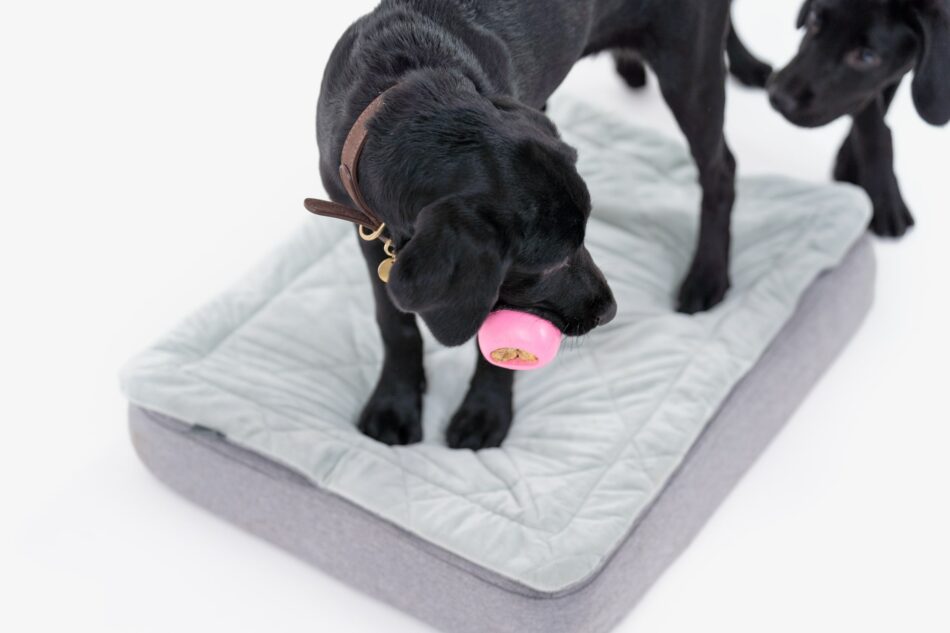
This entry was posted in Dogs
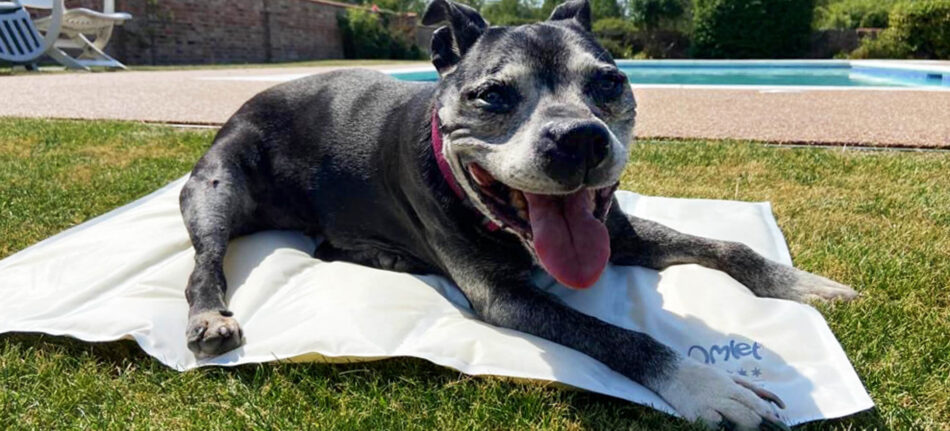
If you’ve ever visited a shelter or rescue, you’ve likely seen a wide variety of dogs of different ages looking for their forever home. But if you’re looking for a canine companion that’ll provide you with lots of love, fewer growing pains and a chance to slow down and enjoy life more, look no further than adopting an older dog.
Caring for a dog of any age requires work and patience. And while older dogs may come with a few more responsibilities than other rescues, don’t let those grey muzzles deter you. Adopting an older dog will save their life, but the rewards you get in return will be far greater. Let’s take a look at everything you should consider before adopting an older dog.
At what age is a dog considered old?
When it comes to a dog’s age, does it really matter? There are many misconceptions about how old a dog is when they reach their ‘senior’ years because a lot of the ageing process is heavily dependent on the specific dog breed. Many believe that a dog is technically an older dog by the time they reach the age of 7 because of the infamous 7 to 1 human to dog years rule. In other words, a 7-year-old dog would equate to the age of 49 in human years by comparison. But we’re betting there are a lot of people in their late 40s who would argue they’re not yet old!
To really try and understand if a dog is an older dog, you can look at their breed-specific average age span and then calculate the last 25% of their life as being their senior years. So, for example, if a dog’s predicted life span is 11-12 years, then their senior years would likely start around age 8 or 9. Keeping in mind that these numbers are all averages and that every dog is different even among like breeds.
Why adopt an older dog?
The better question to ask yourself is why NOT adopt an older dog? Puppies and younger dogs are great, too, but with an older dog, you receive some extra benefits that are truly worth considering when looking to add another furry member to your family. Here are some reasons you should consider adopting an older dog:
- Already toilet-trained: It would be rare to find an older dog that’s not already potty-trained. These dogs have been around awhile and ‘know the ropes’ better than their younger counterparts. So right out of the gate, you have one less basic skill to teach your new friend as they have likely already mastered it.
- Deeper connections: With age comes the knowledge of what it means to be loved by their person. Older dogs have a much better understanding of this concept, and as a result, are usually quicker to form a strong bond with you.
- Calm temperament: If you’re seeking a chilled canine companion who would rather snuggle on the sofa than chase you in the yard, then an older dog is where you should look. While older dogs still have energy to run and play, their puppy years are far behind them and they tend to be more relaxed and calm.
- Second chance matters: You can rest assured knowing that by adopting an older dog you will not only be rewarded with love and appreciation, you will also have the gratification of knowing you gave them a second chance. Every dog deserves a home filled with love and great care, and older dogs should be no exception to that.
Teaching an old dog new tricks
They say you can’t teach an old dog new tricks, but the truth is, you absolutely can! The amount of training an older dog has under their belt will vary, but they almost all have the basics covered. Training any dog requires patience and work, but chances are with an older dog, they will pick up on new tricks quicker as they tend to retain lessons faster than younger dogs and puppies.
Keep in mind that older dogs do come with older bodies, so they could get injured more easily if given new tricks that are too challenging or difficult. For that reason, make sure you really know what you are getting yourself into before adopting an older dog. Take time to research the specific dog breeds and ages that are best suited for your lifestyle before bringing home your new best friend.
Gentleness and patience are the keys to helping an older dog settle in. For many, these dogs may have spent the last few weeks, months or even years in a shelter so they will be entering your life with some expected nervousness or anxiety. Ensuring they have an easy transition into your home will require patience and time to let them get used to their new surroundings and routines.
Senior dog essentials
While every dog breed is different, most older dogs want to spend the rest of their best years doing what they love most – relaxing! So in order to make sure your older dog is as comfortable as they can be, here are some essentials you should have:
- Supportive dog bed: Just as mattresses are important to us as we age and change, so too are the beds that our dogs sleep on. And that is especially the case for older dogs. To give your older dog the most comfortable sleep, you need a supportive memory foam mattress that will provide the utmost comfort for their joints and muscles. The Topology dog bed, designed by Omlet, is not only a practical and stylish bed for your older furry friend, but it’s engineered with versatility for you to customize specifically for your dog!
- Temperature regulators: Like us humans, dogs tend to become more sensitive to temperatures the older they are. These senior pups are more susceptible to heat stroke and heat exhaustion as they age. So ensure they have a way to cool down fast when the temperatures rise by getting them a cooling dog mat that can be placed on their dog bed or directly under their bodies for immediate relief. And to keep them extra cosy and warm in the winter, make sure you have plenty of soft, snuggly dog blankets to snuggle with.
- Easy clean options: All dogs like to sleep but older dogs like to clock in a few more hours each day than their younger canine counterparts. Because your older dog will be spending more time snoozing, you want to make sure you have a dog bed that is easy to clean and care for so as not to disrupt their coveted nap times. The Topology dog bed toppers are a great option as they are machine washable and easy to clean. Keep an extra one on hand so you can make sure your dog always has a fresh set of sheets to zip on.
Omlet and older dogs
There really is no better gift you can give to a dog or yourself than by adopting. Whether you choose a puppy or an older dog, the rewards you receive in giving these amazing animals a good life are priceless. At Omlet, our mission is to make products that help bring you and your canine companions closer together. From dog beds, to dog bowls and every dog product in between, we want the designs that we create to be just as comfortable, supportive and enjoyable for your dog as your connection is with them.
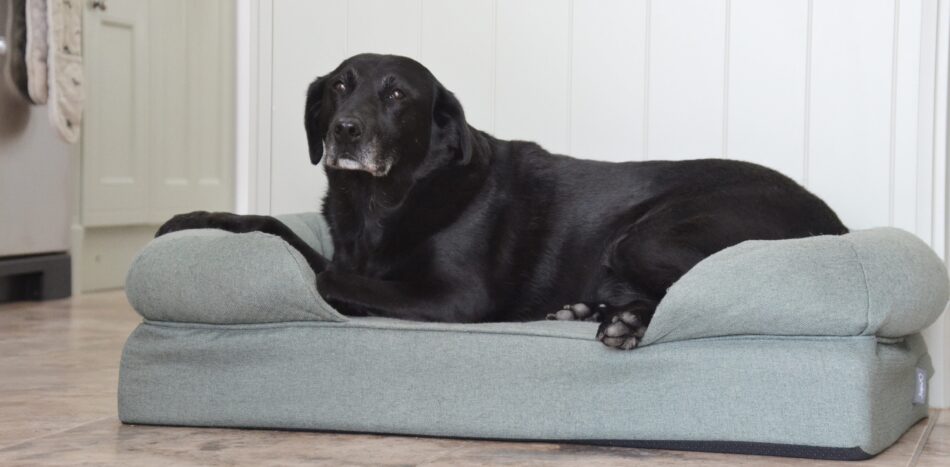
This entry was posted in Dogs
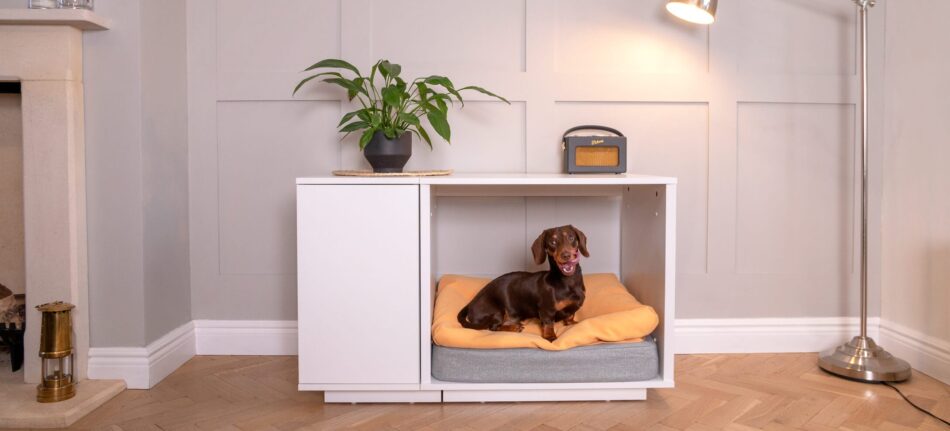
As a dog parent, you know what it’s like to try and keep a tidy house when you have a furry friend. With leashes, dog toys, and dog beds, your house can get cluttered quickly. And while you can hide the dog accessories in a basket or storage bin, concealing the dog bed can present more of a challenge.
How do you make sure your dog bed matches your decor? Thankfully, the task of incorporating your dog’s living space into your own has become much easier with ingenious products and designs. So before you go hiding another dog bed away in the corner, read these tips on how to make your dog’s bed a style staple in your home.
What are the best bed options for your dog?
After getting home from a long day at work, we all want a cozy and comfortable spot to relax and unwind. Your dog feels the same way. The bed your dog sleeps on is often not only their sleep sanctuary but their place of escape as well. So positioning a dog bed near a walkway or in a frequently traveled path of your home is not a good idea.
What if a dog bed could be enclosed like a personal doggy home? What if instead of a worn out pillow lying on the floor, your dog’s bed could be showcased like a piece of furniture? We asked ourselves these very questions and then challenged our product designers to create a solution. After all, giving your dog a space of their own is not only beneficial to their health and well-being, but it will also make your decor space look good while doing it.
A home within a home
Meet the Fido Nook Dog House, designed by Omlet. Engineered as an elegantly modern piece of furniture to complement your home while also providing a cozy space for your dog’s bed. Now you can create a space your dog can call their own while also using it as a functional spot to place plants, pictures or even your basket for keys. But here’s the best part – any dog bed can fit inside the Nook! And by elevating your dog’s bed, you’ll raise their comfort and hygiene and protect them from dust balls, drafts and disturbances.
Having an enclosed dog den is a great way to add style and functionality to your interior. The Fido Nook comes with an optional doggy wardrobe storage where you can place all of your dog’s personal items. If it weren’t for the dog bed inside, you might just think the Nook is another sleek end table to enjoy.
Match your dog’s bed to your furnishings
If it’s not the space, but the look of your dog’s bed that is putting you off, it might be time to upgrade to a more stylish bed that matches your own sofa, bed sheets and cushions. Finding a dog bed that complements your decor is like finding the perfect throw pillow to complement your sofa. Just remember – style is important, but comfort is king when it comes to dog beds.
Is your interior decor a neutral palette with warm and soft tones? Then perhaps a soft gray or beige color dog bed will look best. But if your home decor is filled with bold and bright colors, opt for a dog bed to match your fun style! Did you know that you can not only customize your dog’s bed color but the fabric as well? With the Topology Dog bed, designed by Omlet, you can choose from 5 different fabrics to include quilted, sheepskin, beanbag, microfiber or bolster. Choose the fabric that suits your dog and then select the color that matches your decor.
It’s also important to remember that dogs shed. And those musty been-outside-in-the-mud odors can very quickly permeate their sleeping quarters. With Topology, you can wash your dog’s “sheets” when you wash your bed sheets so you both can enjoy that fresh sheet feeling! Simply zip off the topper and throw it in the washing machine for a quick and easy clean dog bed.
A stylish upgrade
To truly incorporate your dog’s bed into your interior, you can look to upgrade with accessories. Just like the blankets and pillows that adorn your couch and chairs, you can give your dog the same feeling of opulence with their own items.
A super soft dog blanket is the perfect way to upgrade your dog’s naps and your decor. Whether you drape it on their bed or over the sofa, adding a dog blanket brings texture and depth to your interior while also providing endless hours of additional comfort for your dog. It’s a win, win situation.
For the standalone dog beds, you can heighten the luxury look and your dog’s health by simply adding feet to the base of the bed. With the Omlet line of dog bed feet, you can choose from a variety of different looks and styles including wood, gold hairpin and modern metal rails. Match the feet to the tones and textures of your decor to enhance the look and feel of your space. And your dog will appreciate an elevated level of comfort and hygiene in the process.
The Omlet design options
At Omlet, we believe dogs are family members, too. So where they sleep and spend their time should be reflected in your home. Incorporating your dog’s bed into your decor doesn’t have to be difficult. And once you’ve decided if you want a dog den or just a dog bed, you can start customizing to match your interior design needs and the needs of your dog. With countless options and products, we make matching your dog bed to your decor a breeze.
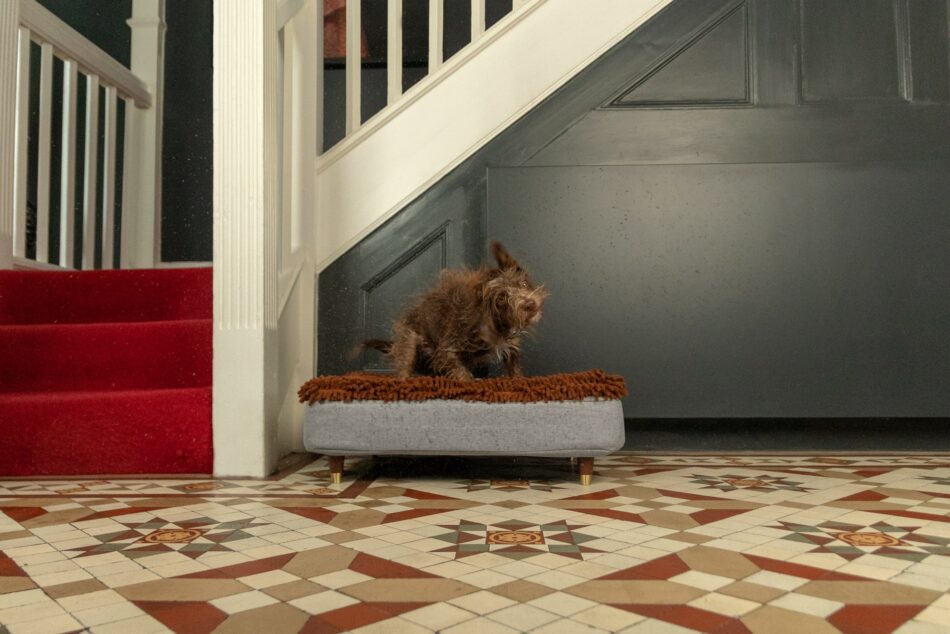
This entry was posted in Dogs
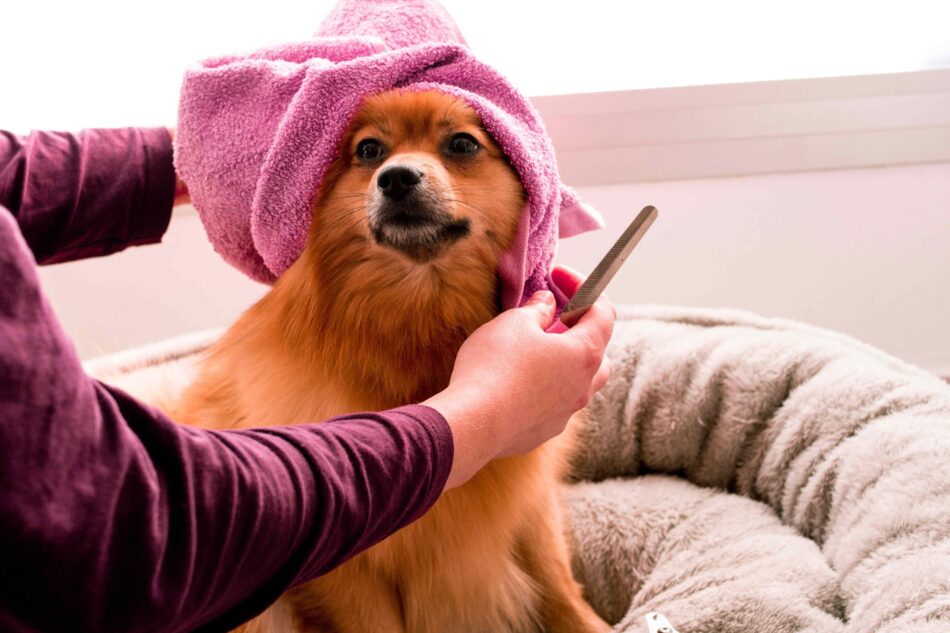
Everyone deserves a day of tranquil relaxation! When the stresses of life get hectic, treating yourself to a day at the spa can make all the difference. But do you know what’s even better? Treating your best four-legged friend to a spa day! That’s right – pampering your pooch not only benefits your dog with de-stressing relaxation, but the act of giving an indulging wellness experience will bring you and your pup closer together. Here’s everything you need to know on how to give your dog a spa day.
Setting up the spa environment
When planning to treat your dog to the ultimate escape of calm and serenity, you first need to make sure you have the spa essentials on hand. Does your pup just need a blissful bath or will they get a massage and pawdicure as well? Decide ahead of time exactly what spa specials you want to give your pup and then gather the shampoos, nail trimmers and brushes all together so you have them in one place.
Next, pick out the perfect place to pamper your pooch! Whether it’s in a large bathtub, walk-in shower or outdoor lanai, make sure the spot you pick is quiet and calming. This will ensure the spa experience is relaxing. You can even play some soft music, such as classical or nature sounds, to add another layer of tranquillity.
If this is the first time you are treating your special friend to a spa experience, it’s a good idea to have one of their favourite dog blankets on hand to help them stay at ease. Some dogs are unsure about new things and having a familiar scent and snuggle will allow them to enjoy the spa day much more quickly!
Now before you begin the spa day, you want to be sure you give your dog a bit of exercise first to get them nice and tired. Help your dog ease any jittery feelings by taking a brisk walk around the block or playing a game of fetch. Giving your dog a workout beforehand will help keep you from having to workout too hard trying to keep them still during the spa! A relaxing spa day is the perfect reward after some exercise!
Doggy massage
Who doesn’t love having their sore muscles massaged? Dogs carry stress and strain in their joints and muscles just like we do. So spending time gently massaging your dog can provide continuing benefits of relief and relaxation for your pup long after the spa day is over! Here are some tips on how to give your dog the ultimate spa massage:
- Always start slowly and with gentle pressure when giving your dog a massage so they can get used to the experience.
- Begin the massage by using your thumbs to make small, circular motions on your dog’s head.
- If your dog is maintaining a relaxed state, slowly work your way onto their shoulders and down their back by applying the same gentle pressure.
- Your dog may decide to roll over and request a belly rub, which is completely normal! Feel free to scratch that tummy while also massaging through any tension points.
The massage portion of the spa day may last a few minutes or more depending on your dog’s temperament and comfortability with the new experience. Pay attention to your dog’s body language and adjust accordingly so the massage remains a positive experience. Before long, your dog might just be begging you for more!
Blissful bath time
For some dogs, the ‘b’ word can be a dreaded sound that means “run for cover under the bed”! Your dog’s hygiene is vital for their health but bathtime doesn’t have to be a bad time! Creating a welcoming and calm environment is the key to success with spa day baths. Follow these essential bath time tips and your dog will start running for the tub instead of the covers the next time they hear the ‘b’ word!
- Since the bath is the spotlight of the spa day, you want to be sure you have the water temperature just right! Keep it on the warm side and add some soothing scents of lavender or chamomile oils to make it more inviting. Spa day baths should not be done with the outdoor water hose!
- Slowly introduce your dog to the bath – nobody wants a spa day to feel rushed! Once you can see that your pup is relaxed and ready to be pampered, you can slowly begin wetting down their fur.
- Apply generous amounts of shampoo onto your dog to create a luxurious lather. This is the part of the bath experience where you can really create that calming effect by gently massaging in the shampoo and getting them clean!
- Once rinsed off, towel dry your dog completely from head to tail. When done right, your dog will look just as good as they smell!
Doggy spa day baths are the best part of the experience! Not only does your dog get a soothing and relaxing treatment, but you get a clean and fresh smelling dog!
Pawdicure and proper grooming
No doggy spa day is complete without the final touches of a pawdicure and brushing! Depending on your dog’s breed and coat, you may need to spend a little or a lot of time brushing them. But even just a regular dog brush can work wonders at removing dead hair and redistributing skin oils throughout their coat. Maintaining a regular grooming schedule for your dog is essential not only for spa days but throughout the year!
When it comes to nail trimming, dogs and pet parents alike can become hesitant! But more than for just looks, keeping your dog’s nails trimmed is important in making sure they can walk and run without issue. How do you know if your dog’s nails need to be trimmed? The best rule of thumb is to listen as they walk on a hard floor – if you hear the click-clacking of nails, it’s time for a trim!
If trimming your dog’s nails on your own, be sure to start out small, only cutting away tiny tips at first. You can even use a doggy nail file to more swiftly whittle down the excess length. However, if giving your pup a pawdicure is not something you are comfortable doing, you can always seek out the assistance of a professional groomer to help!
Your dog gives you unconditional love every day! So pampering your pup with a relaxing massage, bubbly bath and essential grooming is one of the best ways you can show them the same. A doggy spa day means spending more time with your dog and that will make the experience that more special. Your dog is a big part of your world, but to your dog, you are their whole world! So give them a spa day to show them how much you care!

This entry was posted in Dogs
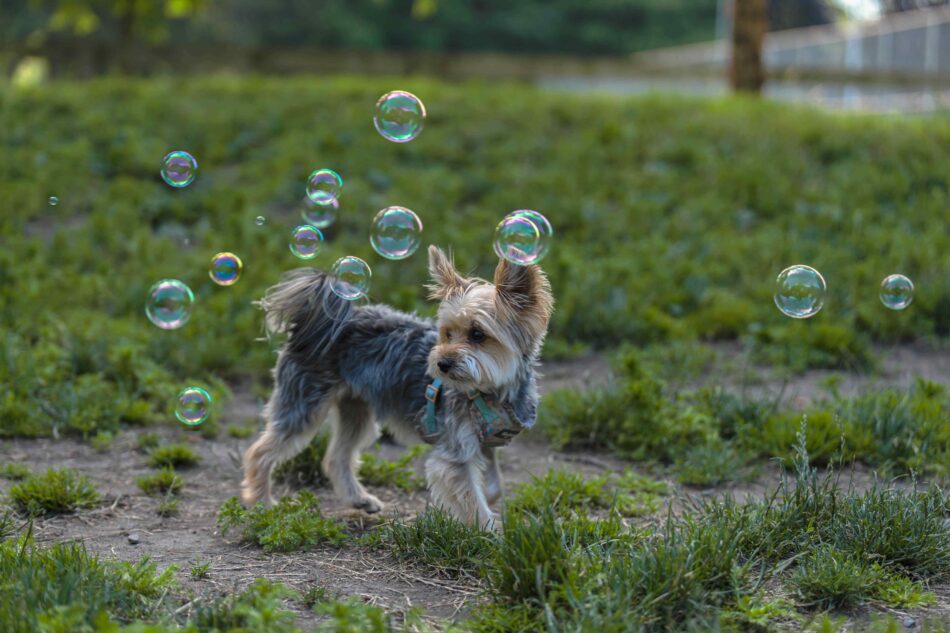
Your dog has lots of energy and loves to run and chase things. Be it toys, sticks or a slobbery tennis ball, the act of chasing is an innate trait in dogs. But has your dog ever chased after bubbles? An enriching game of running, chasing and jumping after bubbles is one of the best ways to engage your dog in mental and physical activity! With easy to make DIY recipes, tips and tricks, we have everything you need to know on how to make dog-safe bubbles.
Do dogs like bubbles?
What dog doesn’t like chasing after a soapy floating orb of water and popping it with their wet nose? For most dogs, playing with bubbles is as fun as any other playtime activity! While certain dog breeds may enjoy the challenge of chasing bubbles more than others, there’s no denying that every dog receives the benefits of brain/body coordination and physical movement when playing with a bubbly concoction!
Think about the last time you blew bubbles for your child or even just for yourself. There was running, chasing, jumping and lots of fun involved! The same is true with dogs and bubbles! It’s a highly engaging activity for dogs that entertains the focus of the mind and the movement of the body! And bonus – playing with bubbles means you get to spend more time with your furry best friend!
Are regular bubbles safe for dogs?
Go to any toy store or party store aisle and you will find every colour, size and scent of bubble solution available. But are store bought bubbles safe for your dog? We don’t recommend them. Here are some important facts to consider when it comes to buying ready made bubbles for your dog:
Even though packaging is labelled “non-toxic”, it can still contain some ingredients that are harmful to your dog. Some of the chemicals used in ready made bubbles are harmless to humans but could cause chemical burns or upset stomachs for your pup, especially if your dog likes to pop the bubbles with their mouth!
Dogs like to lick in order to sense the world around them. So an accidental spill of store bought bubbles could mean lots of harm for your dog if ingested. It’s always important to remember that when using any substance around your dog, harmful or not, to keep at a safe, out-of-reach distance to avoid any disasters!
There are now a variety of “dog specific” bubbles on the market, complete with meat and bacon flavours! However, be sure you read all the ingredients before purchasing. Even with these special made solutions, there can sometimes be a remnant of ingredients that will still pose a danger to your dog if ingested.
DIY dog-safe bubble recipes
With too many unknowns that come with store bought bubbles for your dog, it’s best to stick to at home recipes that you can make yourself. Not only are these DIY bubbles inexpensive and easy to make, but they are safe for every member of your family to play with – two and four legged alike!
The following recipes all include washing up liquid and it’s important to note that the amount used will not harm your dog in bubble form. However, still adhere to the “keep out of reach” rule when playing with these bubbles as an accidental ingestion of the entire solution could cause your dog some serious GI issues.
Simple solution
1 cup water + 1 Tbsp washing up liquid (ex: Fairy)
Combine together in a bottle or dish until well mixed.
Advanced solution
½ cup biodegradable washing up liquid + 1 cup water + 1 tsp glycerin
Mix together in a resealable container and store overnight for best results.
Flavoured solution
1 cup water + 2 Tbsp castile (vegetable-based) soap + 1 Tbsp glycerin + 1 tsp bone broth
Mix well in an airtight container and let it stand overnight before using.
Now that you have the bubble solution, it’s time to make bubbles! You can use a variety of household items to help create the popping party – straws, strainers and even whisks all work well at creating bubble magic! You can even bend a paperclip into a rounded shape to try and mimic a traditional bubble stick! No matter how you choose to make bubbles, your dog’s going to love it!
How to introduce your dog to bubbles
Just as with any new experience, some dogs may be initially confused with bubbles. Can you remember the first time you saw these tiny water circles floating around you? It was strange wasn’t it! So be patient when first introducing your dog to bubbles. Let’s check out these helpful tips:
Doggy see, doggy do: One of the best ways you can show your dog that bubbles are tons of fun is by chasing them yourself. When they see you having fun, they will quickly understand they can, too! If you have kids, get them in on the fun as well and before you know it, the whole family will be chasing bubbles around!
You can also get down on your dog’s level and gently blow a few bubbles so they can get a better viewpoint. Hold a bubble in your hand and pop it with your nose so your dog can experience the wonder of this activity.
Bubble machine: If you have kids, you’re in luck!, because that means you most likely have a bubble machine. And when it comes to making bubbles for your dog, what better way than with one of these! All of the homemade dog-safe bubble recipes are ok to use in a machine and will make your job much easier on producing bubbles!
Safety measures: All dog-safe bubbles contain soap – and soap is slippery! So to avoid any potential slips or falls, it is best to have your dog play with bubbles outdoors. If indoors is the only option, be sure to do the activity on a non-skid surface so fido doesn’t lose footing! Be sure to also pay close attention to your dog when playing with bubbles and never leave them unattended. Too many bubbles near the eyes means irritation for your dog, so if you see them acting uncomfortable, immediately wipe away any soapy residue before you resume play!
Seeing your dog chase, jump and snap at bubbles is not only entertaining, it’s also great exercise! But if for any reason your dog doesn’t find the fun in bubble play, or gets bored with them quickly, you can always encourage continued play with dog toys! And don’t forget to have a comfortable dog bed for fido to rest on when all that bubble playtime is over!
This entry was posted in Dogs
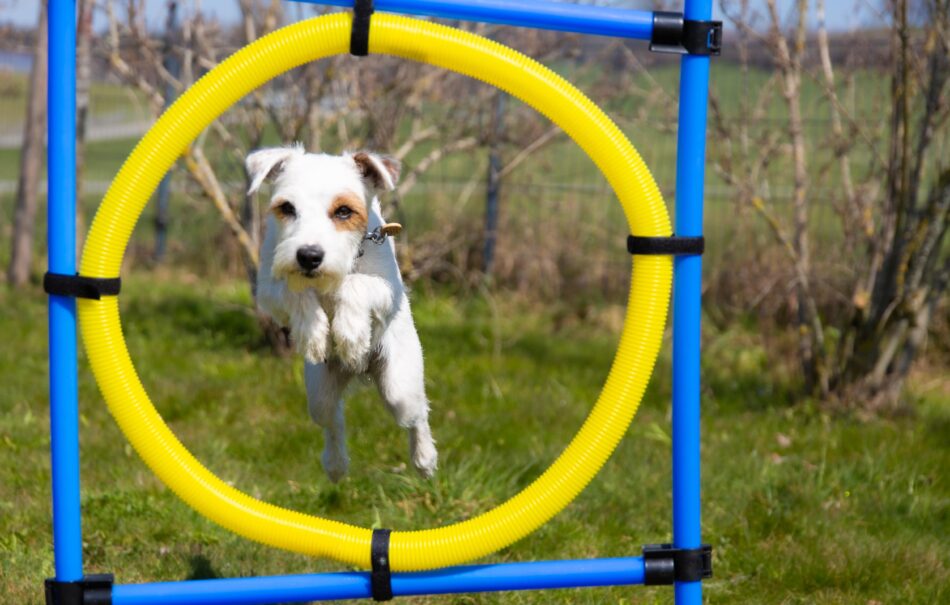
Creating a doggy obstacle course at home is much easier than you think! You already have materials in and around your house that can be used for agility and provide your dog with the incredible benefits of physical exercise and mental stimulation. And any activity that involves you and your dog working together is sure to build a closer bond between you both! Start your obstacle course today with these simple tips and tricks!
Can all dogs do agility?
The great thing about agility training is that every dog breed can do it! The only exceptions to this type of activity would be puppies younger than 12 months due to their still developing joints or any dog that has a medical condition, such as arthritis. But, if your dog falls into one of these categories – there are still many ways you can keep your dog active and stimulated!
So what exactly is agility? Simply put, agility is a series of obstacles paired together to form a course for your dog to navigate through with direction. It doesn’t matter if your dog has training experience or not – you can start easy and small and work your way up as you and your dog learn more.
You love spending time with your dog and creating an obstacle course is just one more way to bring you both closer together! As with any new activity, if you have any concerns about your dog’s ability to participate, consult with your vet first to be sure.
Safety first!
Before getting started creating your at home doggy obstacle course, you want to make sure you pick out a location with enough space to allow room for lots of movement. This may be indoors or outdoors depending on your home and backyard. The most important thing to remember in keeping this activity safe for your dog is to remove any objects from the area that could potentially hurt your dog or get damaged. After all, your dog will be running and jumping!
Now that you have your course location picked out, you want to make sure your dog is familiar with listening to and following commands. Any doggy obstacle course is only as good as the human that is verbally navigating where to go, so make sure you practice simple commands so you both are comfortable and stay safe. Your dog doesn’t have to become a professional but a simple understanding of commands such as sit and stay are a great starting point!
Once your obstacle course is set up, you want to make sure you give your dog a good warm up before running through it. You wouldn’t try a new physical activity without first properly stretching, right? The same goes for your dog! Just a quick walk around the block or a game of fetch will suffice to warm up your dog’s muscles to safely enjoy the obstacles.
Hurdles and jumps
If you and your dog are new to obstacle courses, jumping is a great first activity to try. But how do you know what height to set your jumping bar to? It all depends on your dog! Smaller dogs, like Chihuahuas or Dachshunds, only need a short height to try and clear while bigger dogs, like Labradors and German Shepherds, should be able to jump over higher obstacles.
So what can you use to create a hurdle for your dog to jump over? Here are some great ideas with materials you likely have at home already:
- Grab two laundry baskets and a curtain rod. Place either end of the curtain rod onto each laundry basket and, voila! You have a jumping hurdle! Move the rod up or down for varying heights depending on your dog’s ability.
- Have any PVC pipes laying around from an old plumbing project? These make a perfect tool to make a hurdle of any height!
- Check your beach bag for a leftover pool noodle – they make great jumping hurdles! Not only are they soft, they are also easy to hold for your dog on their first obstacle run!
There are countless options that can be used to create a DIY hurdle for your doggy obstacle course. Just make sure they are lightweight or soft so they do not hurt your dog in all the fun. And if your dog has never jumped over a hurdle before, you can encourage them to explore the new activity with dog treats or verbal commands. No matter your dog’s age, you can teach them new tricks!
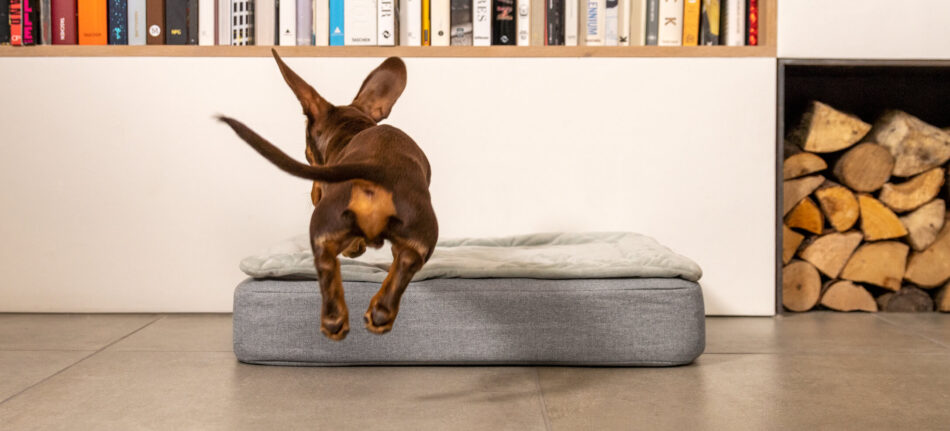
Zig zag
Next, you can move on to the weaving portion of your obstacle course. Similar to the hurdle portion, you want to make sure the materials you use for the zig zag are lightweight or soft to avoid your dog getting hurt!
Let’s take a look at some options to make a zig zag obstacle for your dog.
- If you have kids, you likely also have some small orange play cones as well. These make a great option to set up a zig zag for your dog’s obstacle course! Start spacing them out far apart to allow your dog plenty of room to navigate. As your dog gets better at weaving you can slowly move them closer together.
- Not sure what to do with all of your leftover cardboard boxes? Use them to make the perfect weaving obstacle! Not only are boxes lightweight and easy to set up, but if your dog crushes them in their run, you can simply break them down to recycle.
- Did you know some Christmas decorations make a perfect zig zag obstacle for your dog? Before you put away your plastic candy canes from the yard, try using them as part of the course. These lightweight poles are a great option to train your dog to weave in and out of.
Start out slow when teaching your dog to weave in and out of any object. With consistency of hand and verbal commands, your dog will quickly learn this new and fun activity!
Tunnels
The tunnel portion of the obstacle course may be the most intimidating for your dog if they’ve never done agility training before. One of the best ways to help your dog learn? Make sure you navigate the tunnel first to show them how it’s done!
Creating the perfect tunnel obstacle for your course is as easy as setting up items you have around your house. Here are a few options to choose from:
- Line up some chairs and drape a lightweight blanket across them. Now you have a tunnel! Show your dog how to go under the chairs by crawling through yourself so they can follow the fun! If your dog is of bigger stature, you may need taller chairs or pick a different option.
- Do you have a collapsible fabric tunnel that your kids climb through? Your dog can use this fun toy, too! Get the whole family in on the fun of a doggy obstacle course by having your child show your dog how to crawl through the tunnel first.
- Those large cardboard boxes can be used once again! Open up both ends of the box to create a square-shaped tunnel and watch your dog run in and out with ease.
While some dogs may enjoy running through tunnels more than others, agility training is an enriching experience for every dog!
Putting it all together
Once you have created each individual obstacle, you can start to put them all together to create the ultimate course! Be sure you have practised the hurdles, zig zag and tunnels all separately before you set them up in any sequence. This will ensure your dog is familiar with what to do.
You can set up the course any way you like! Does your dog like the zig zag the best? Put that obstacle at the start of the course to encourage movement through the rest of the obstacles. Once you have created each separate obstacle you can move them around to try different combinations and course options!
The trick to any successful doggy obstacle course experience is patience, consistency and fun! And having plenty of dog treats on hand will help to encourage activity and reward hard work! Creating an at home obstacle course is a great way to add exercise to your dog’s life and create a closer connection between you and your best friend!
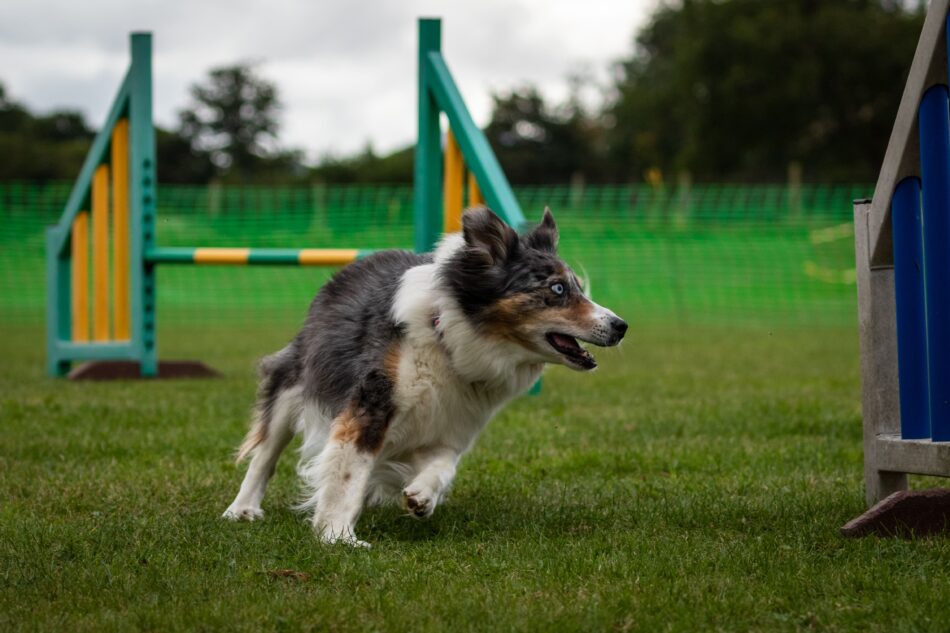
This entry was posted in Dogs
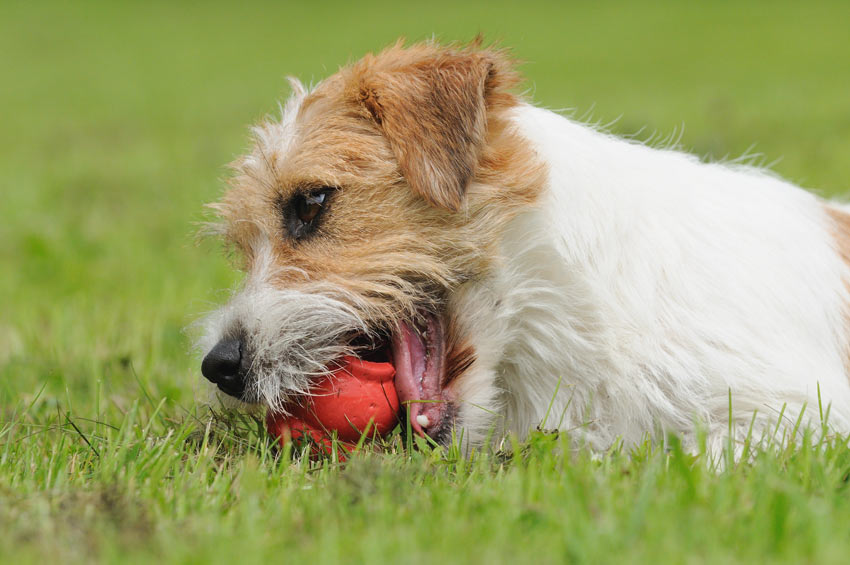
If you’ve ever given your dog a Kong you know how fantastic these indestructible toys are at keeping your pup active and stimulated for long periods of time. Not only are they great for games of fetch, but they’re also great for stuffing yummy treats inside to encourage mental agility with reward! To better help your dog’s natural instinct of hunting food, here are some delicious recipes you can make to stuff inside your dog’s Kong!
Kong benefits
Before we dive into the treats, let’s first explore why Kong toys are so beneficial for dogs in the first place. The hard rubber chew toy was first invented over 40 years ago by Joe Markham as a way to stop his German Shepherd from chewing up all his socks. Since then, dogs all over the world have enjoyed the fun of a Kong toy! It not only encourages positive chewing habits, but also improves oral health.
For dogs who are prone to separation anxiety and being left alone for too long, the Kong is also a great way to keep their brains distracted and engaged. Dogs are innately programmed to chew – it’s how they search out the world around them. So having a toy like the Kong that is virtually indestructible is a great way to keep your dog busy and happy!
The Kong was specifically designed with a hole in the middle to house treats and encourage a dog’s natural instinct to hunt for food. The act of hunting the food out of the Kong provides dogs with increased mental stimulation that is super beneficial to their overall growth and development! We know it’s important to maintain a well-balanced diet for your dog, so adding these small, healthy treats to the Kong will provide the benefits of good nutrition and activity!
Recipe #1 – Savoury Snacker
For the dog who craves the savoury tastes and smells of meat, this recipe is sure to get the tails wagging! These ingredients are staples of most households and the recipe is simple to make!
- Take one small sweet potato and microwave or bake it until it is soft in the centre. Once cooked, let it cool for a few minutes. Then, scoop out the inside of the potato into a bowl and mash with a fork to get any lumps out.
- Next, boil plain chicken until thoroughly cooked. You want to make certain this meat is not seasoned as some spices can be detrimental for a dog to ingest. Once the chicken is completely cooked, fork shred a small piece into smaller bite sized pieces and add it to the bowl of sweet potato.
- Last, shred one small carrot into fine pieces and add it to the mixture.
- Stir all ingredients together until they mix and marry completely.
You can add the mixture just as it is to the Kong from here or roll into small balls and place in the freezer for a frozen savoury treat later! Either way, your dog will love hunting down the savoury morsels of this yummy treat!
Recipe #2 – Sweet Treat
Did you know that dogs have a sweet tooth just like we do? While the taste buds of a dog are a fraction of that of humans, their smell is a million times stronger! And when dogs smell the delicious, sugary scents of sweet food they can’t help but indulge! So if you want to treat your sweet pup to a sweet treat, here is a recipe that is sure to have them begging for more.
- Take one cup of plain greek yoghurt and put it into a bowl.
- Next, add two large tablespoons of any nut butter – peanut, almond or cashew are some great options! Whatever you have on hand in your pantry will work!
- Finally, chop up fresh strawberries into small bits or mash up some fresh blueberries into a fine mixture. The sweetness of the fruit is what makes this treat so indulge-worthy!
- Now mix all the ingredients together and then smooth out the mixture onto a parchment lined pan. Place the pan in the freezer for at least 2 hours so it can completely harden. When you are ready to stuff the Kong, simply break off a piece and place it inside!
This sweet treat is sure to provide hours of engaging activity for your dog – with a delicious reward for their work!
Recipe #3 – Dinner Delight
Is your dog an “invite me to the dinner table, too” kind of dog? If your pup has a hard time keeping their nose (and their mouth!) away from the dinner table, this Kong stuffed recipe is sure to occupy their time so you can enjoy a peaceful meal.
- About one hour before your dinner is ready, boil one cup of rice until tender and add to a bowl to let it cool.
- Take one can of plain salmon canned in water and drain it into a strainer so only the salmon meat is left. Mash the salmon into small pieces with a fork and add it to the cooked rice.
- Next, finely chop up some fresh spinach and mix it into the rice and salmon mixture.
- Depending on the size of your Kong, take one spoonful of the combined ingredients and spoon it into the Kong. Then place the stuffed Kong into the freezer.
When you’re ready to eat, take the Kong out of the freezer and give it your pup! We guarantee they will be happily entertained and licking away for the entirety of your dinner, if not longer, with this frozen, delicious treat! And you will have enough of this recipe leftover to make more Kong dinner treats another time.
The Kong toy is a favourite of so many dogs and pet parents because they are easy to stuff with shop bought treats, or allow you to create your own recipes. Making homemade treats to stuff in your dog’s Kong is as easy as combining a base, a protein and an add-in. Some other simple ingredients to consider are cottage cheese, yoghurt, peanut butter, ground turkey, and apples. No matter what treat you make your dog, be sure to have a sturdy and easy-to-clean dog bowl on hand so they can eat any leftovers without much mess. Try out one of these recipes today and let us know how your dog liked them in their Kong!
This entry was posted in Dogs
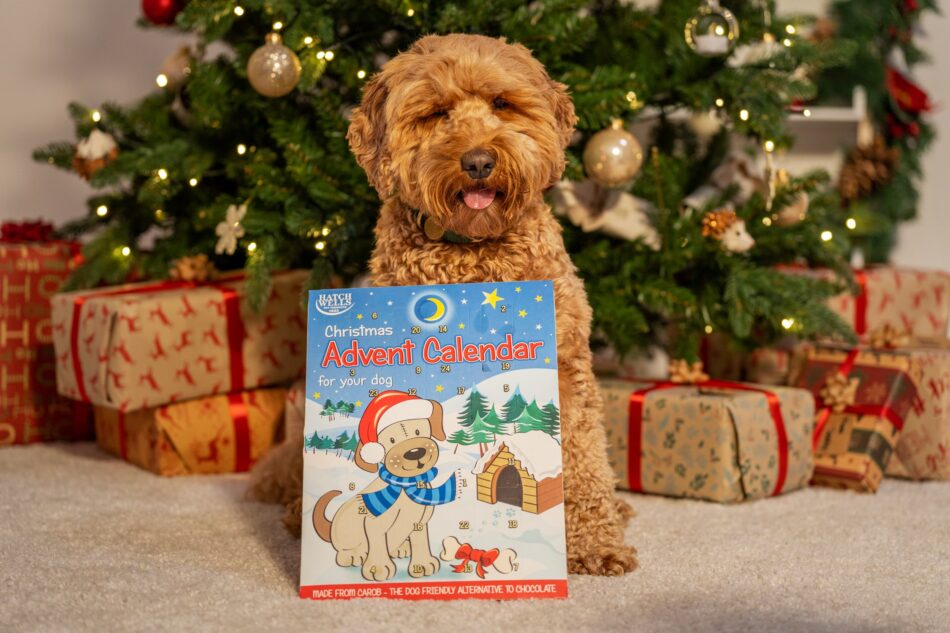
Christmas is a wonderful time to celebrate everyone that we love, including our dogs. With wagging tails to welcome you home and sweet snuggles to keep you warm, our furry friends really are part of the family!
But how can you ensure your dog enjoys the festive period, too? Is it ok for your furry friend to dine on the traditional family feast? Fetch yourself a seat at the table as we outline everything you need to know to make sure your dog stays safe and has fun this Christmas!
Safe Christmas foods for your dog
While feeding your dog from the table can be tempting, serve up safe Christmas foods in their normal dog bowl or as you would a treat. And to be sure your dog doesn’t consume anything harmful, here is a list of some safe foods you can let your pup indulge in small bites:
- Turkey – That’s right! Your dog can have a few nibbles of the star of the show! Turkey is a great source of protein for your dog and they will undoubtedly love a bite (or two!) of the savoury meat. Just be sure their portion is fully cooked, unseasoned, and doesn’t include any skin or bones, which aren’t safe for your dog to devour.
- Potatoes – Serve your pup up some boiled or mashed sweet potato, but be sure to keep it plain with no salt or butter added. Spices like garlic and onion will make them sick, so stick to the plain potato variety when serving your dog at dinner! Dogs can also eat sweet potato – rich in beta carotene, fibre, vitamins, and a super treat for your dog at Christmas!
- Other vegetables – Sprouts, swedes, parsnips and green beans are very popular with dogs, as is a raw or cooked piece of carrot. Again, be sure not to add any seasoning, butter or sauces before you give the vegetables to your pet pooch, and moderation is key!
Not safe Christmas foods for your dog
As any dog owner understands, the nose knows! And especially at Christmas, a dog’s nose will sniff out almost any food or flavour! So in order to make sure your dog stays safe this holiday season, here are a few foods that you want to make sure you avoid letting your furry friend feast on.
- Bones – Give a dog a bone, right? Wrong when it comes to turkey bones! It may seem only natural to give your dog a bone from the carved turkey, but doing so could be very dangerous to their health. Unlike dog chew designed bones that are safe for your dog to gnaw on, turkey bones can be small and splinter, causing your dog to potentially choke.
- Chocolate – Chocolate is a staple in most homes over the holidays, but this tasty treat is not one to share with dogs. Theobromine, which is found in chocolate, can be deadly to your furry friend – even in small amounts. So, no matter how much they give you the puppy eyes treatment, don’t let them have any,
- Gravy – We all know that gravy over a Christmas roast is delicious but it can be harmful for dogs. With its high salt and fat content, this is one Christmas food not to feed fido.
In the unlikely event that your dog does happen to eat any unsafe foods this Christmas, be sure to contact your veterinarian immediately to seek help.
Fido fun at Christmas
One of the best parts of Christmas is the time off from work to relax and enjoy with friends and family. And no family member is more excited about getting to spend time with you than your dog! The most magical time of the year is meant to make magical new memories and who better to do that with!
So take full advantage of this quality time to do more fun activities with your dog. If your furry friend is used to quick morning or afternoon walks before and after work, use this extra time off to linger longer on those strolls. Or, create new adventures and memories by exploring new trails or parks in your area.
What if it’s too cold where you live to be outside for long periods of time around Christmas? Just take the pawty inside! Stock up on some favourite dog toys so you and your dog can play for hours while staying cosy and warm. Your dog will love a good game of “fetch and seek” and you will love that your dog still gets exercise to tire out!
Dogs and guests at Christmas
When Christmas rolls around, you are bound to welcome friends and family into your home. While most dogs love meeting new people and getting pets and pats from strangers, some pups can get very anxious and stressed with too much commotion.
So how do you make sure your dog is ok with the holiday hustle and bustle in your home? Thankfully, Omlet has the tips and products to make sure your dog stays jolly and joyful this holiday!
Extra exercise: A tired dog is a happy dog! So before the fun festivities of Christmas begin, make sure your dog gets plenty of exercise to tire out those wiggles. Take them on a longer walk than usual or for an extra long game of fetch outside before guests arrive. You can also play some mental stimulation games inside so they can release some pent-up energy! That way when your company arrives, your dog won’t feel chaotic or stressed!
Designate a doggie den: For the dogs who get anxious with people coming in and out of your home, creating a familiar place for them to escape to is essential! Place their bed in a quiet room or corner where they feel comfortable and secure so they can get a nap when needed. The dog beds designed by Omlet are a great snooze option for any dog as they can be customised to fit your dog’s exact needs! And if your dog is crate trained, consider upgrading their safe place to a “home within a home” with one of Omlet’s wide variety of dog crates.
Layers on layers: If welcoming guests to your home is a regular and stress-free experience for your dog, then this Christmas should be without worry! For the cuddle pups who like to snuggle family and strangers alike on the sofa, make sure you have some layers to protect your furniture and your guests! The Super Soft Dog Blankets designed by Omlet are a great option because they offer a warm, snuggly spot for your dog to land when greeting guests!
Before you roast your turkey this Christmas, remember to give thanks for the constant companion in your life! We think dogs can receive love in many different ways and that’s why we created our exclusive line of dog products to give thanks back! Making sure your dog enjoys the magic of the holiday season is just as important as the festivities themselves!
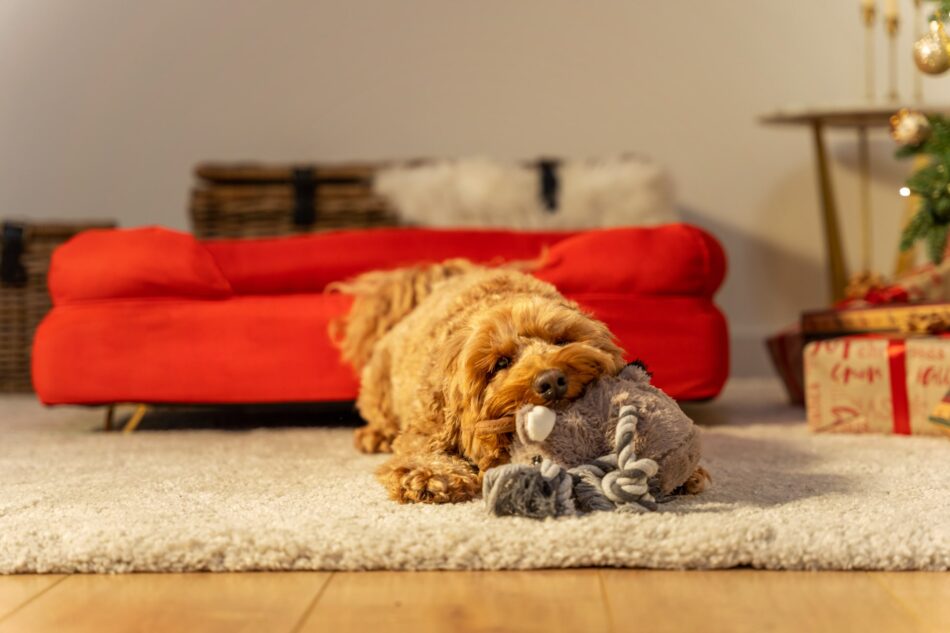
This entry was posted in Dogs








